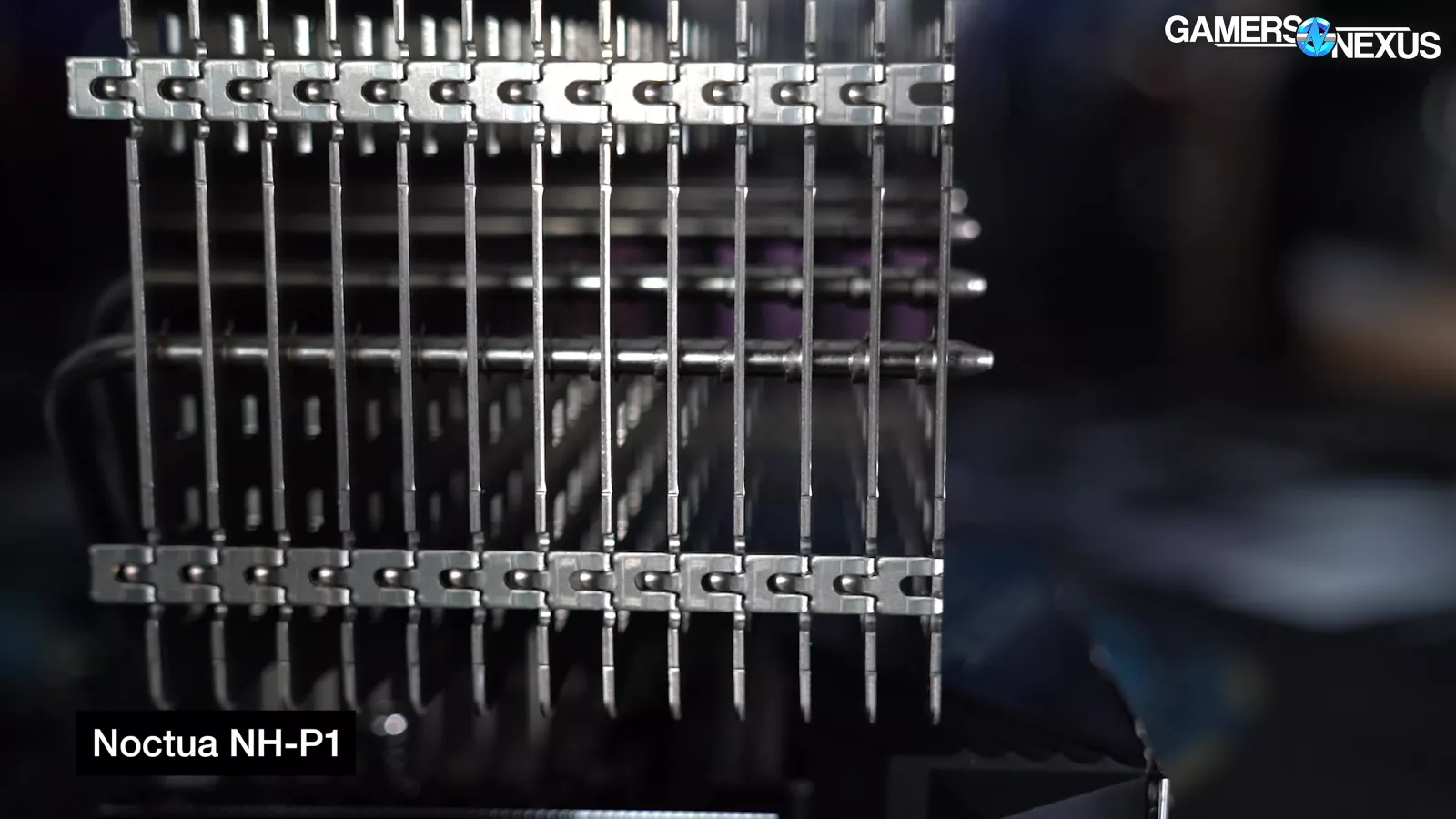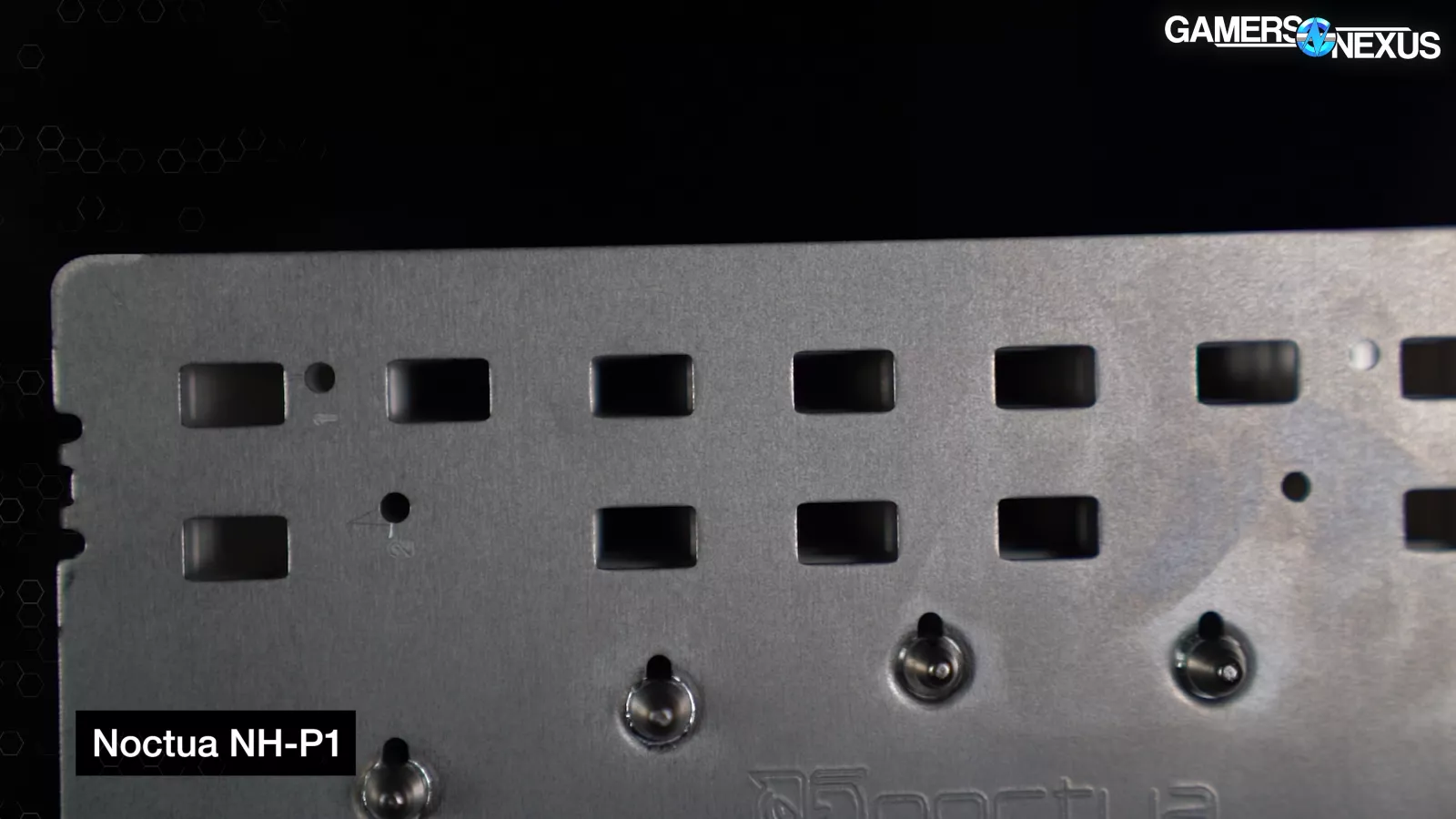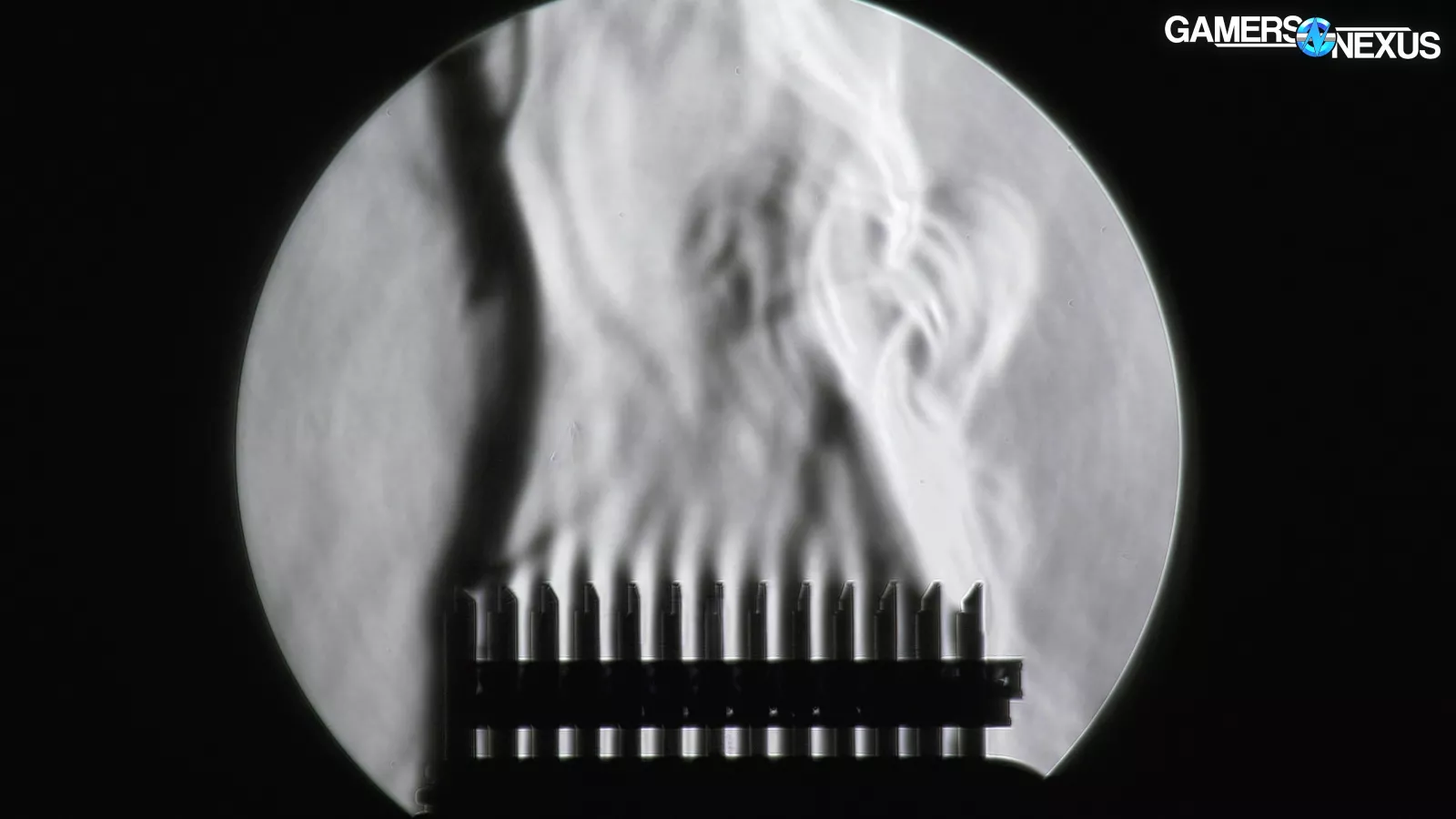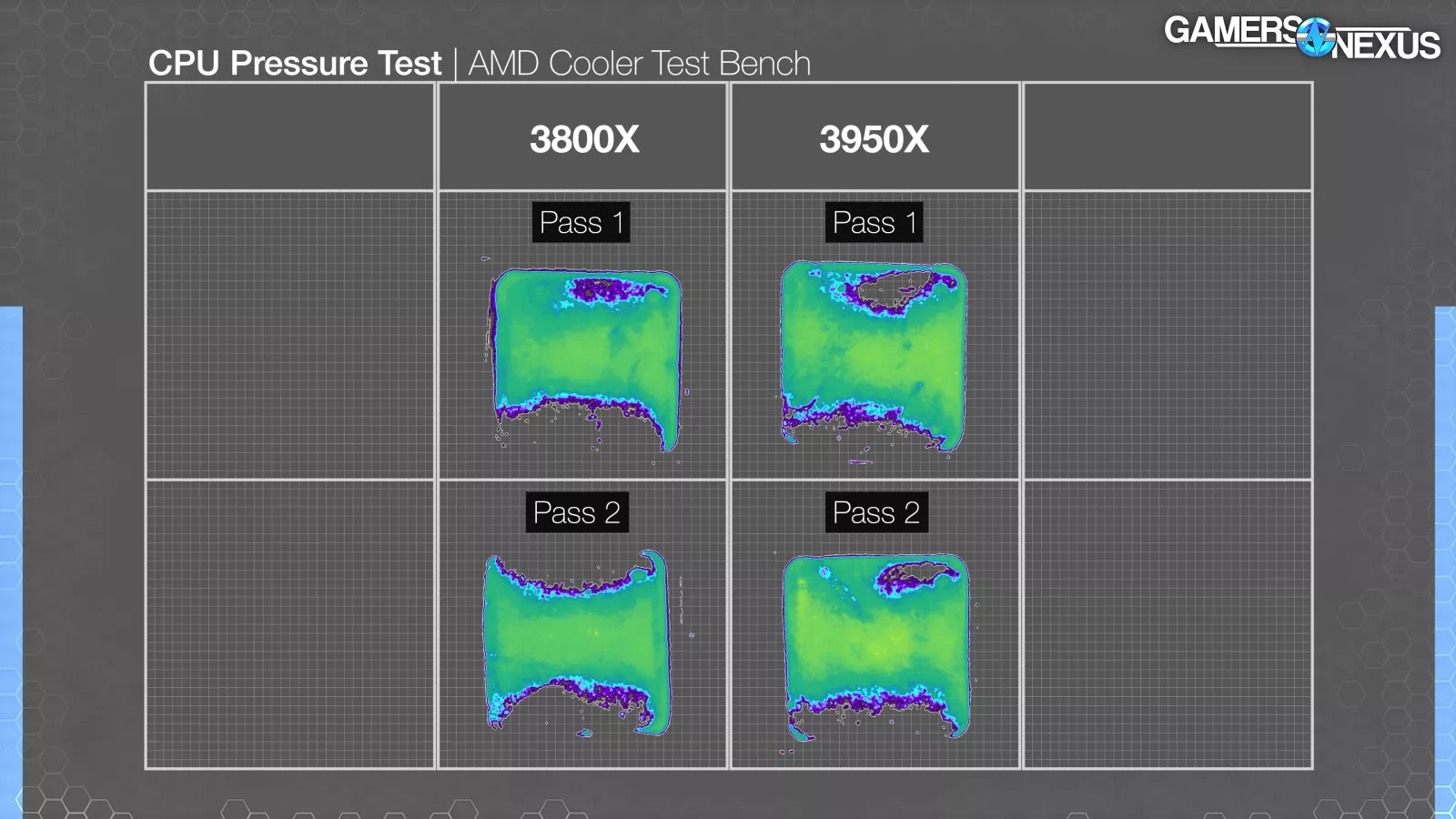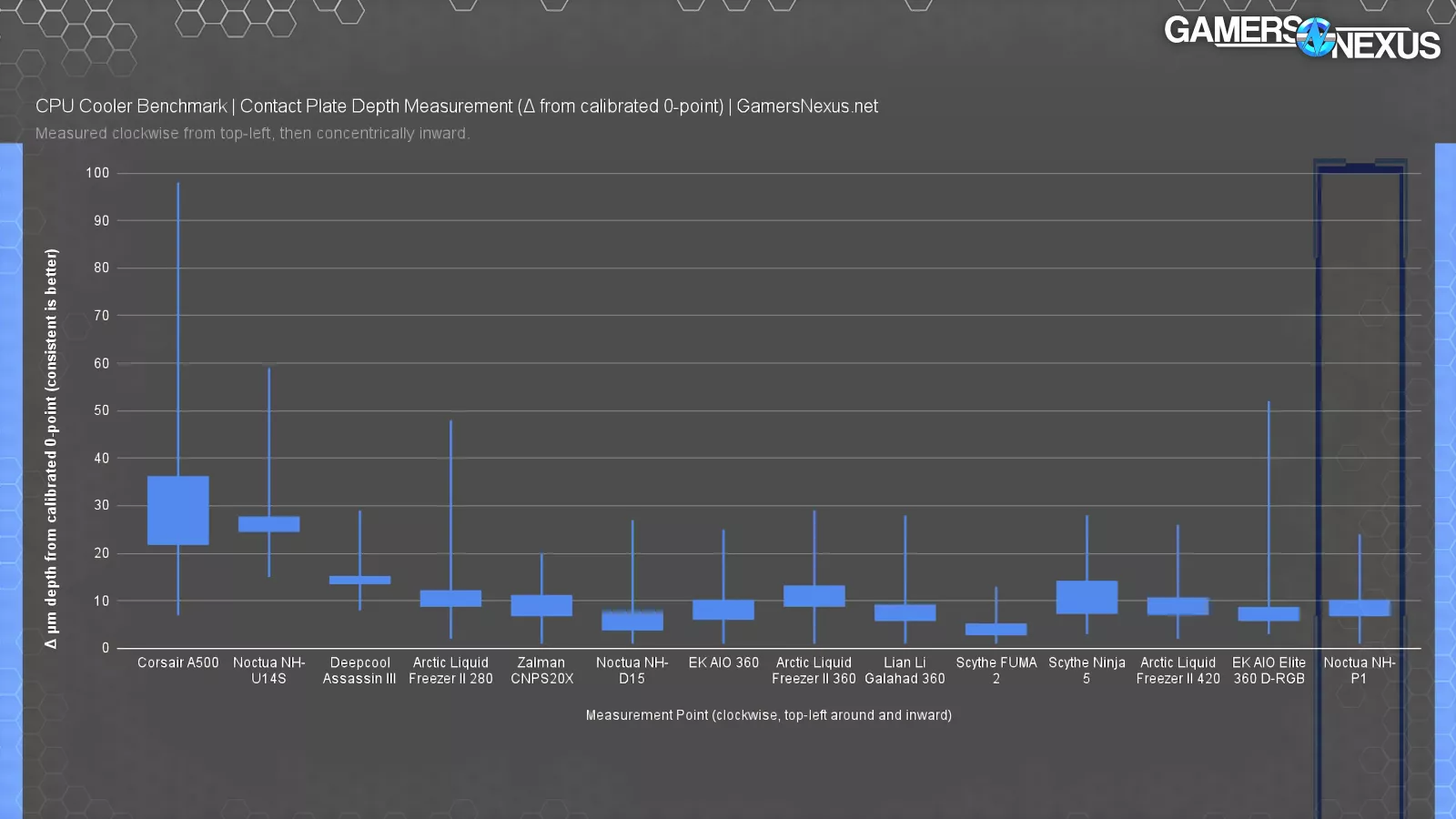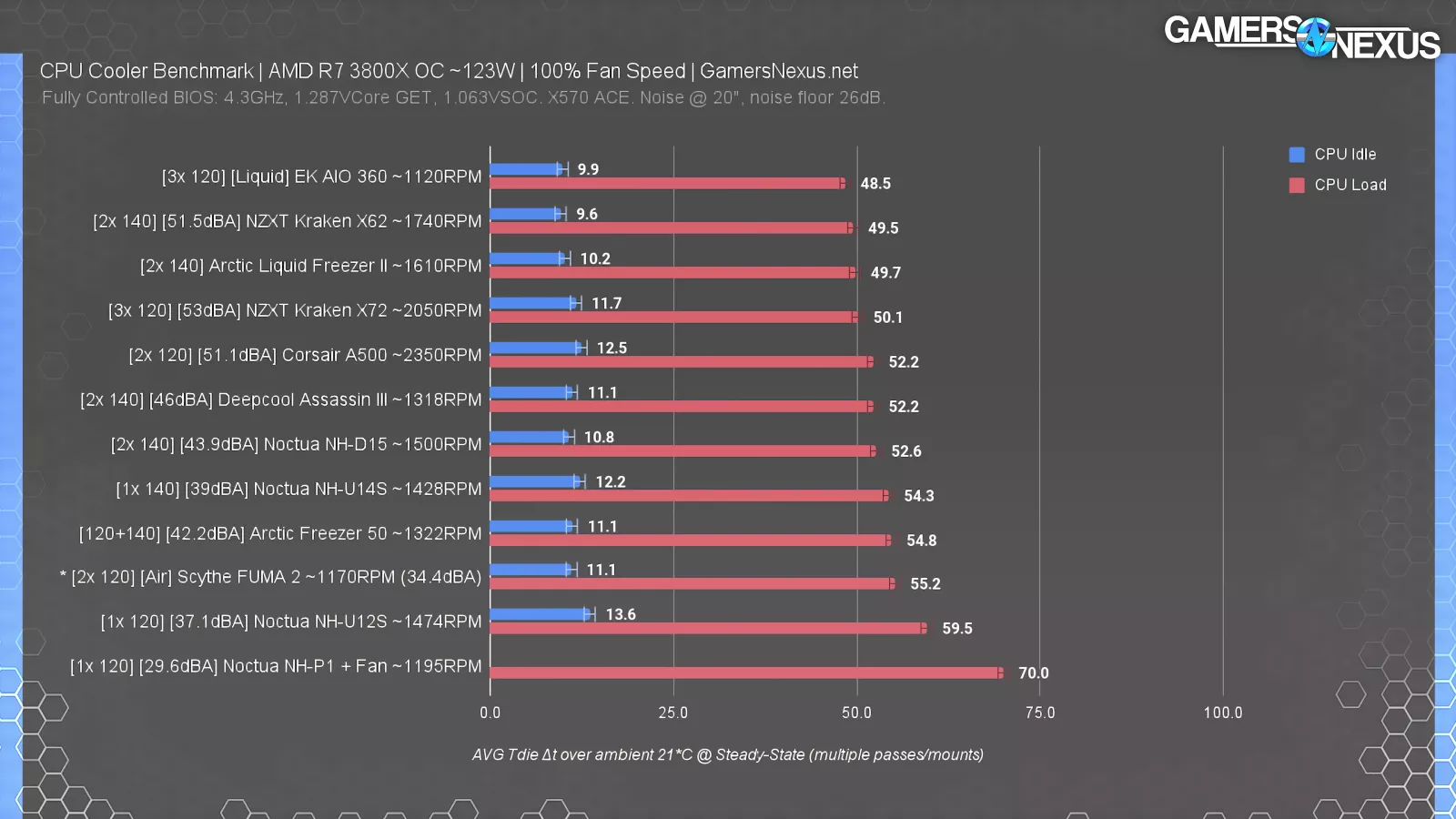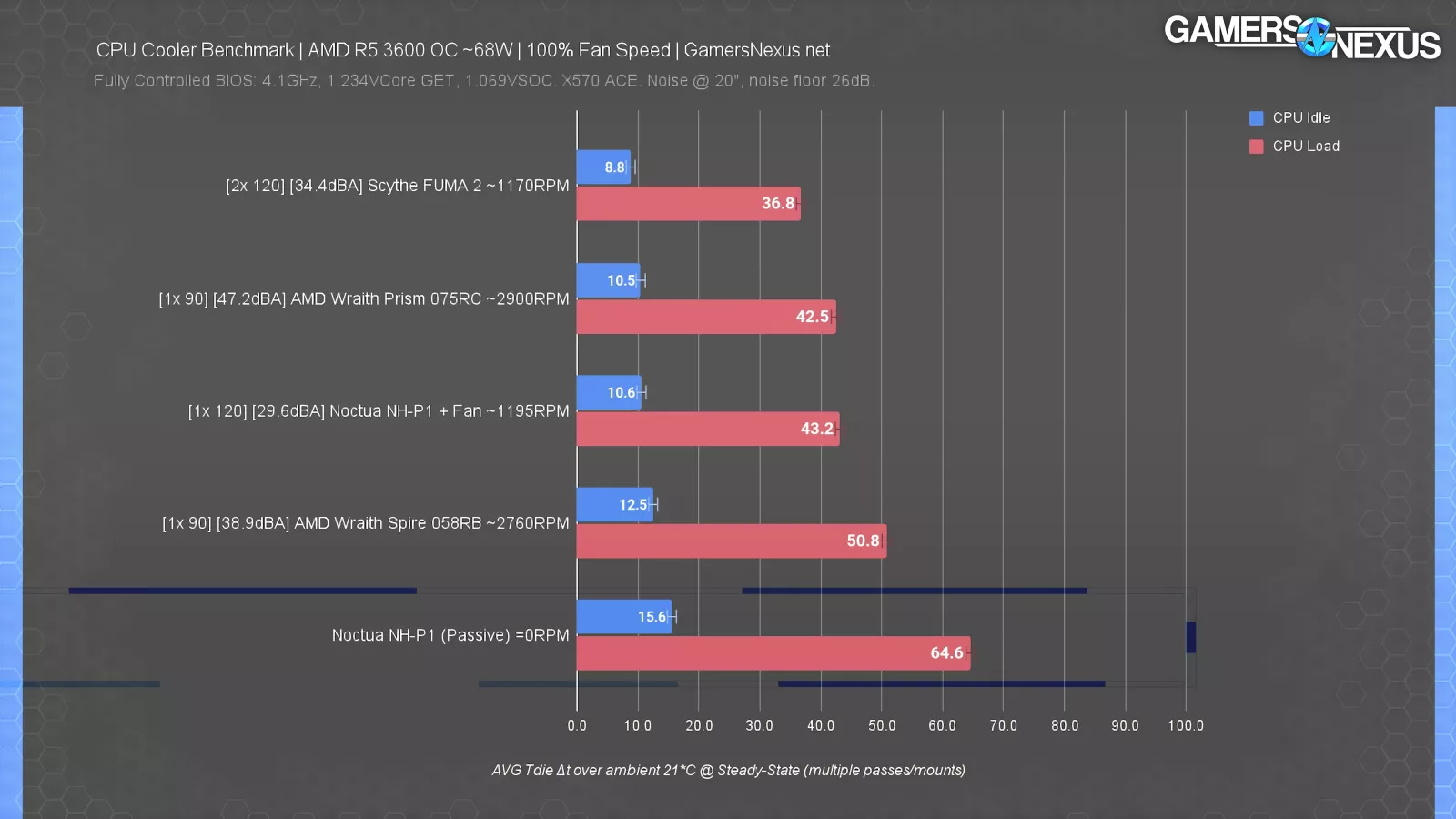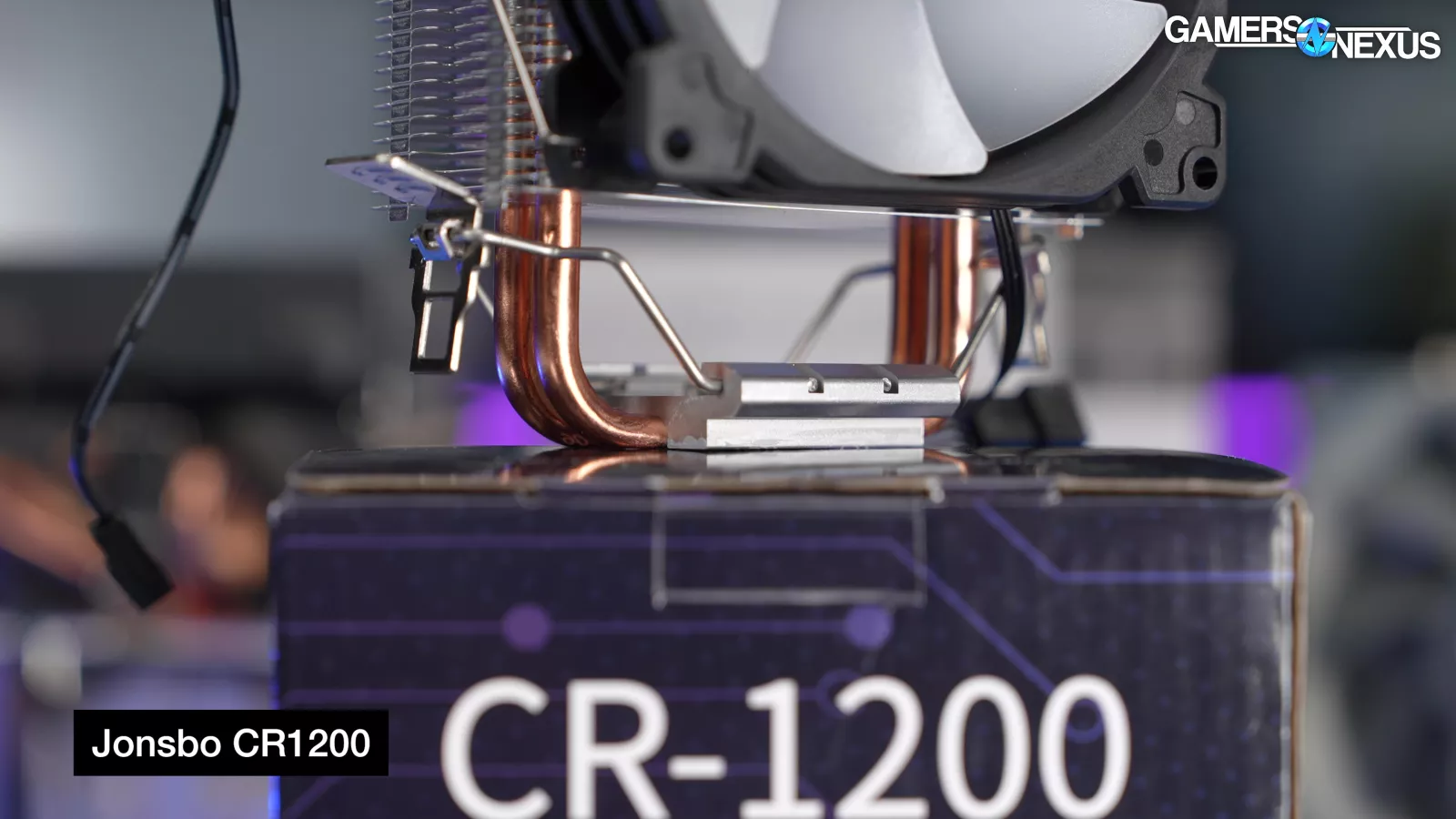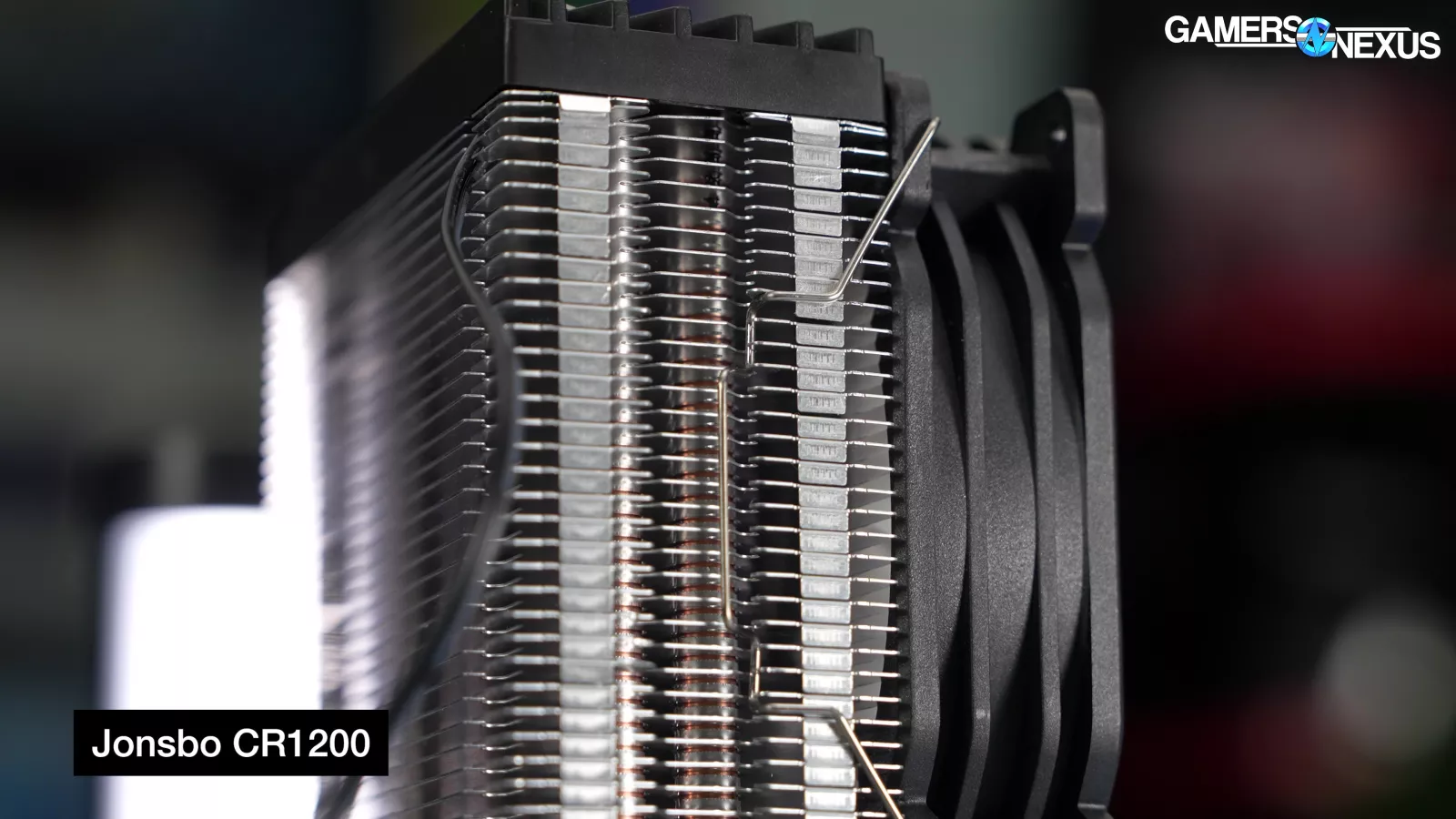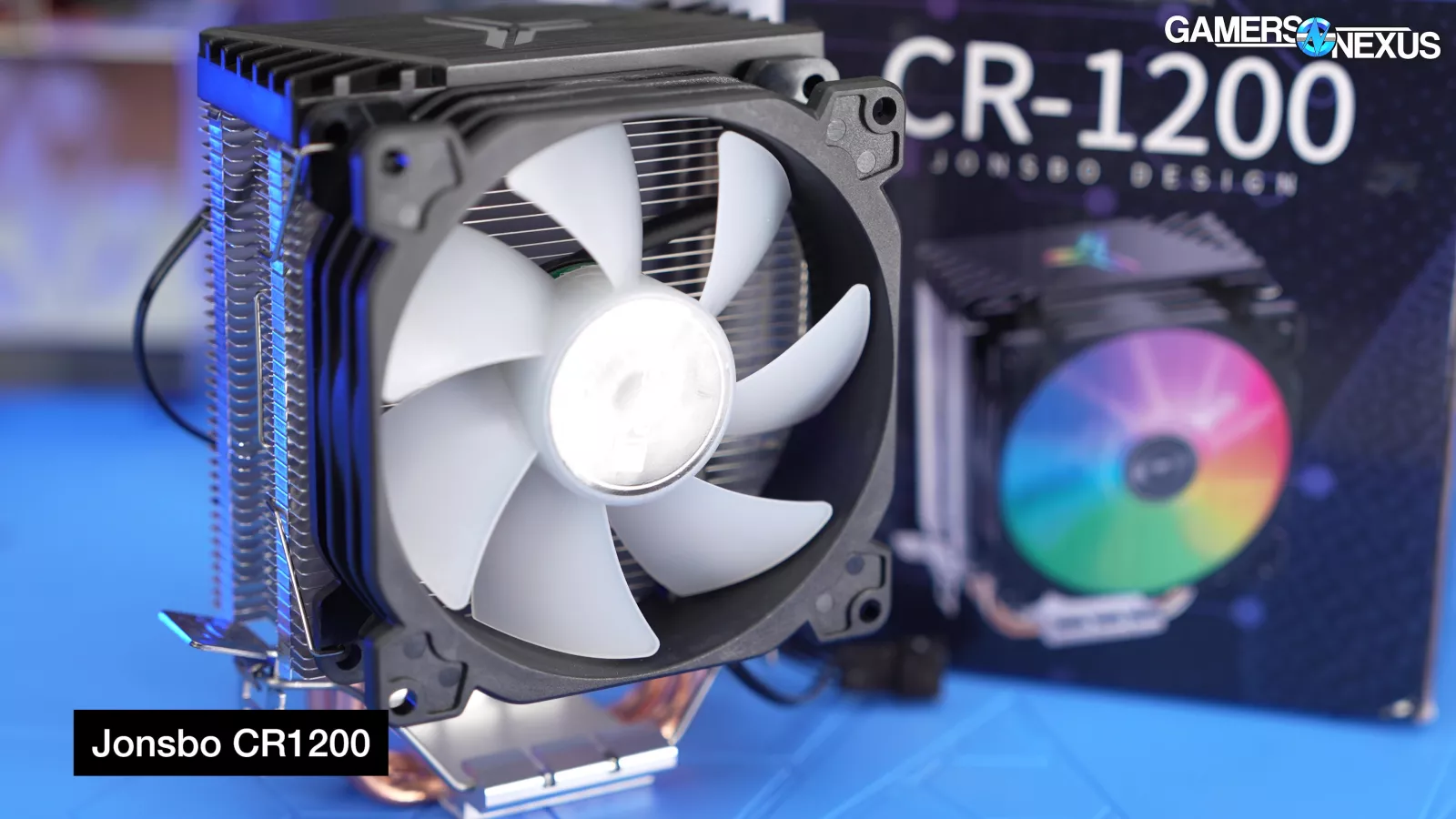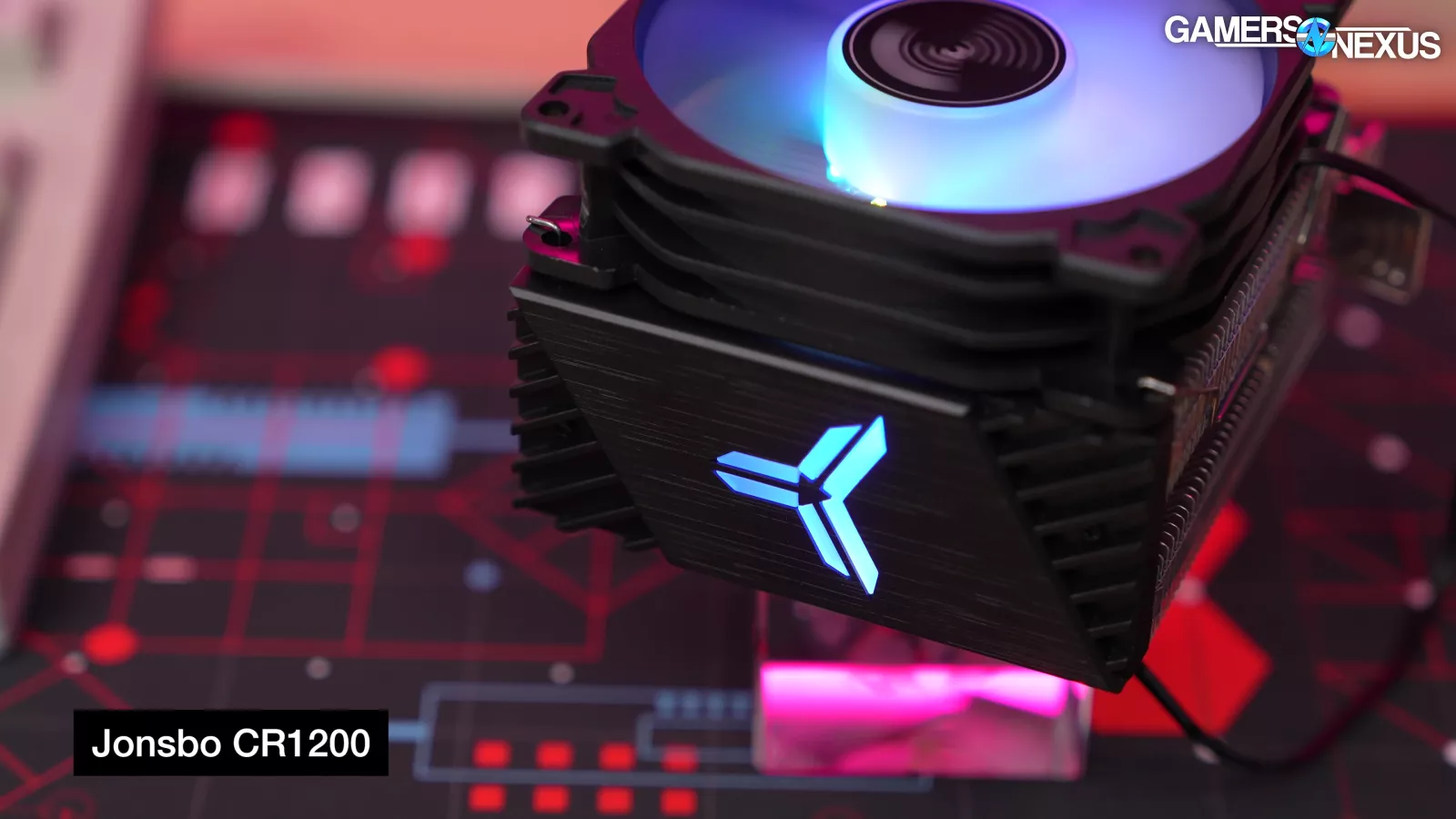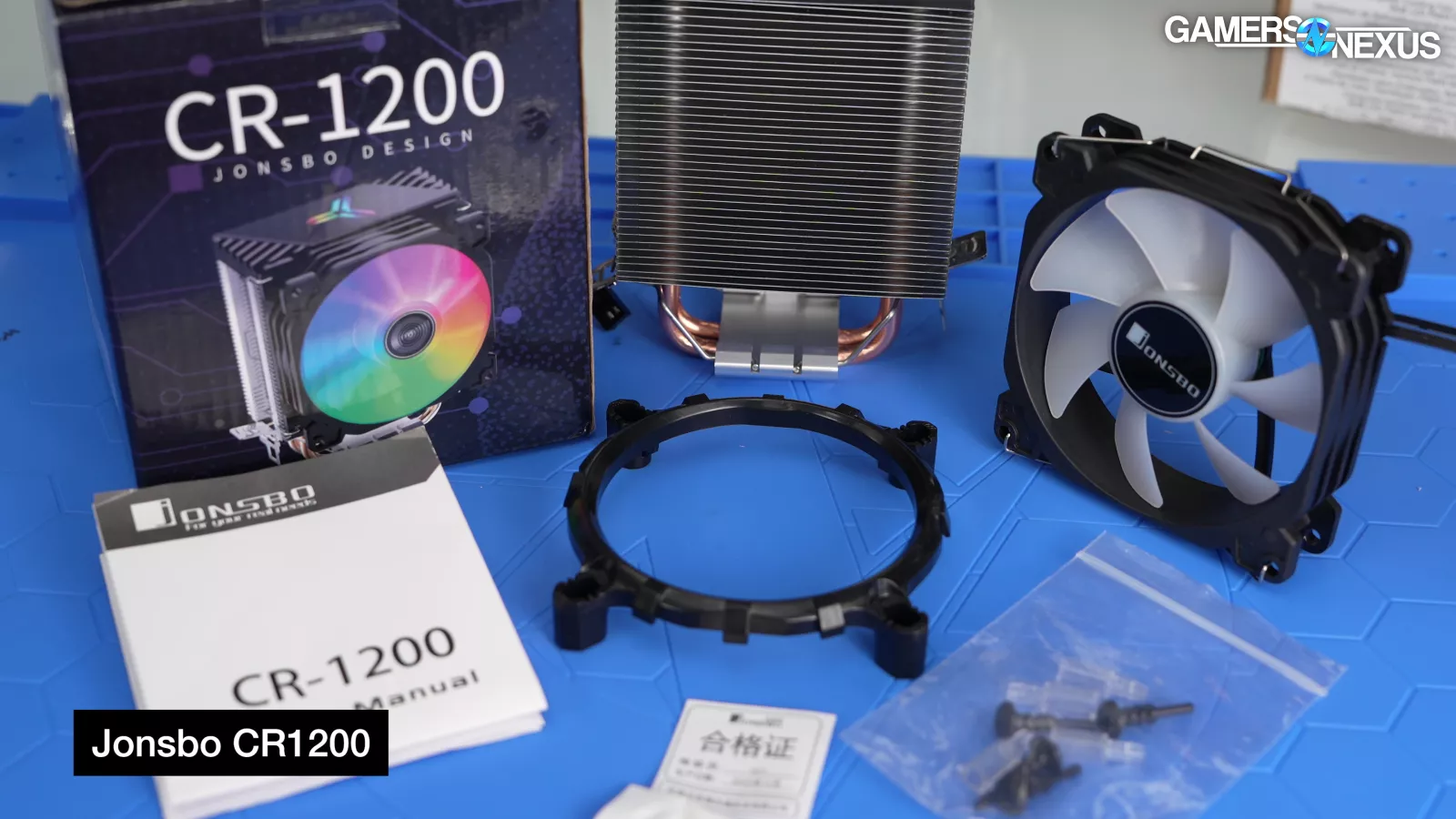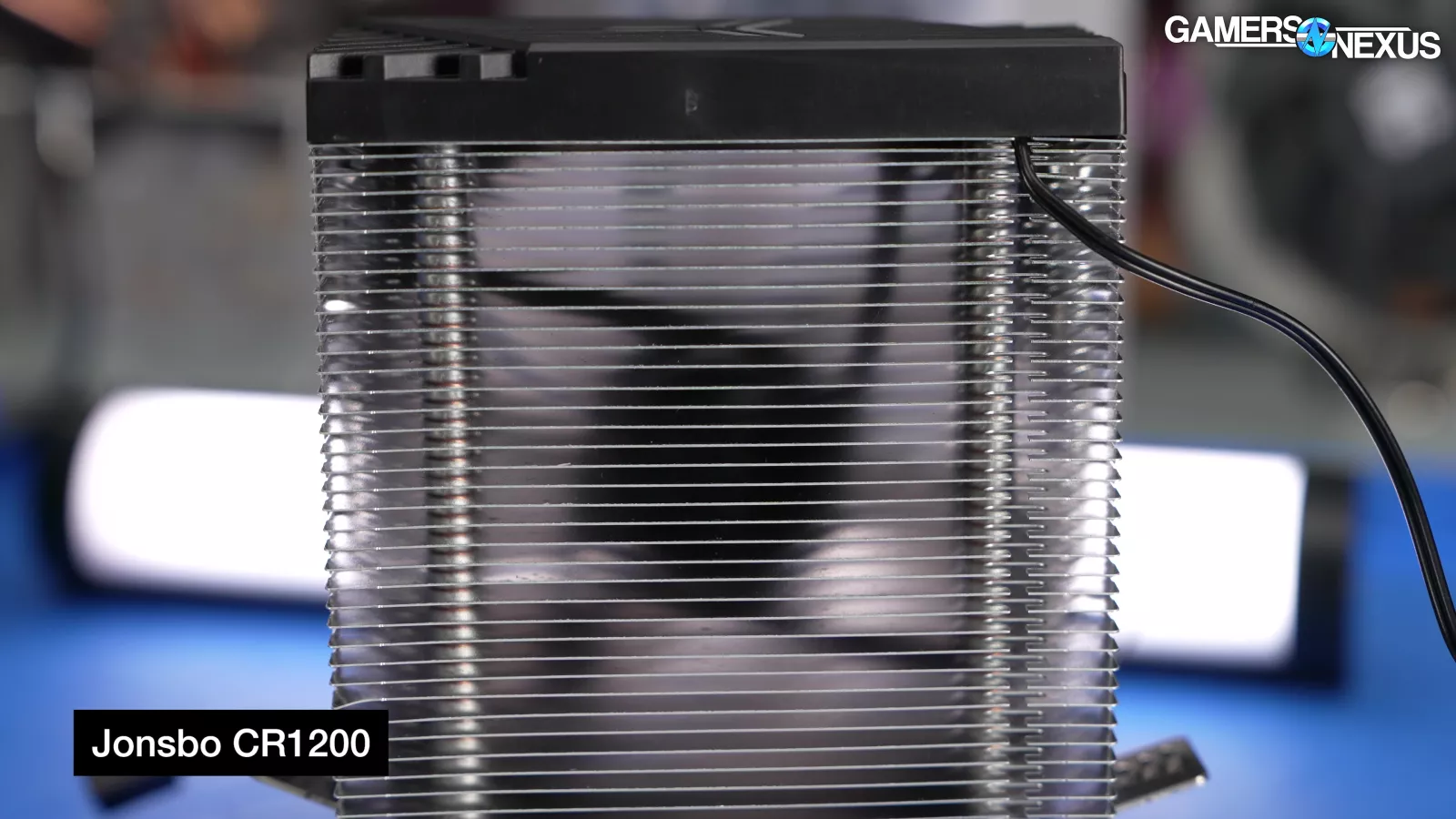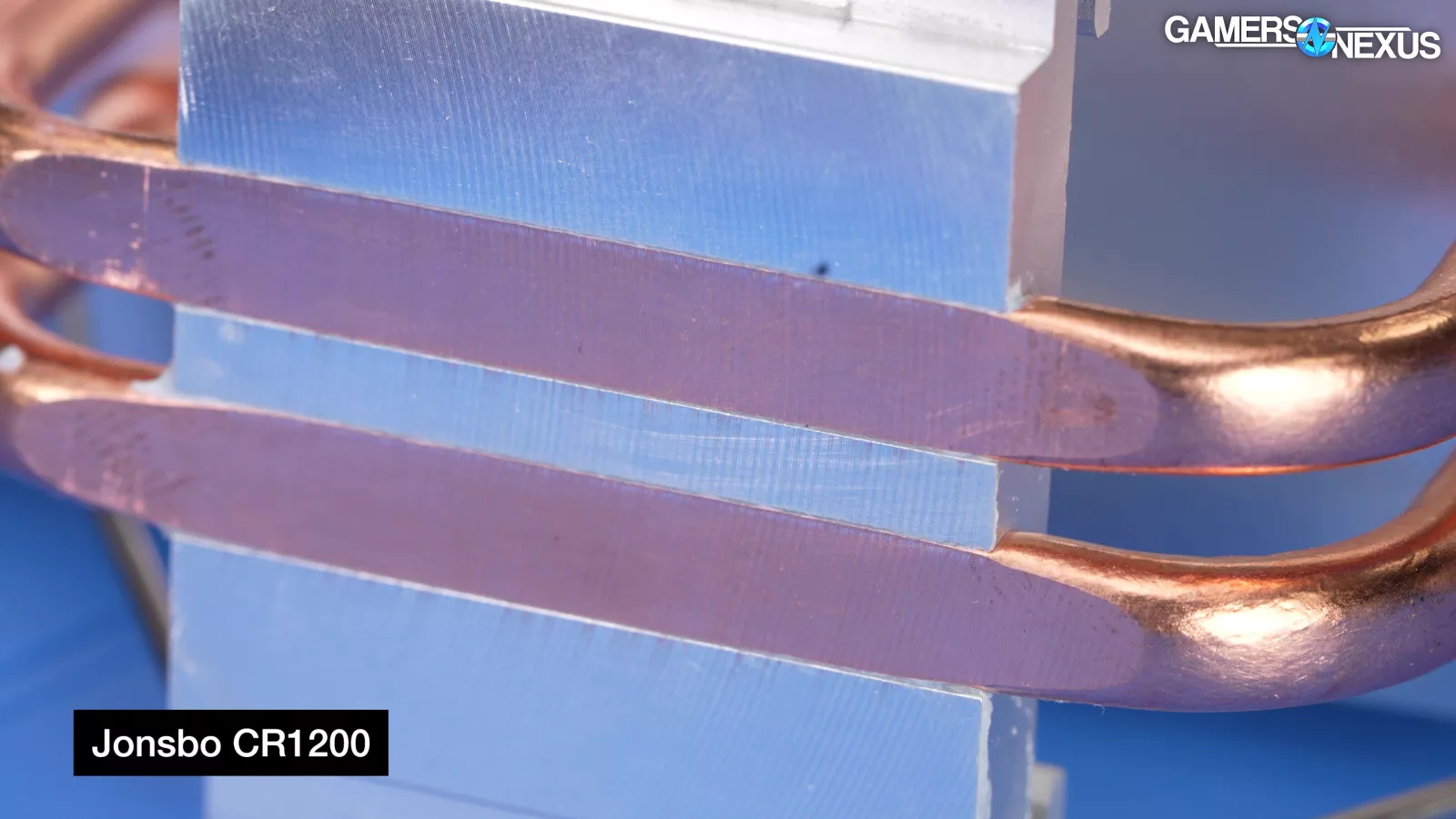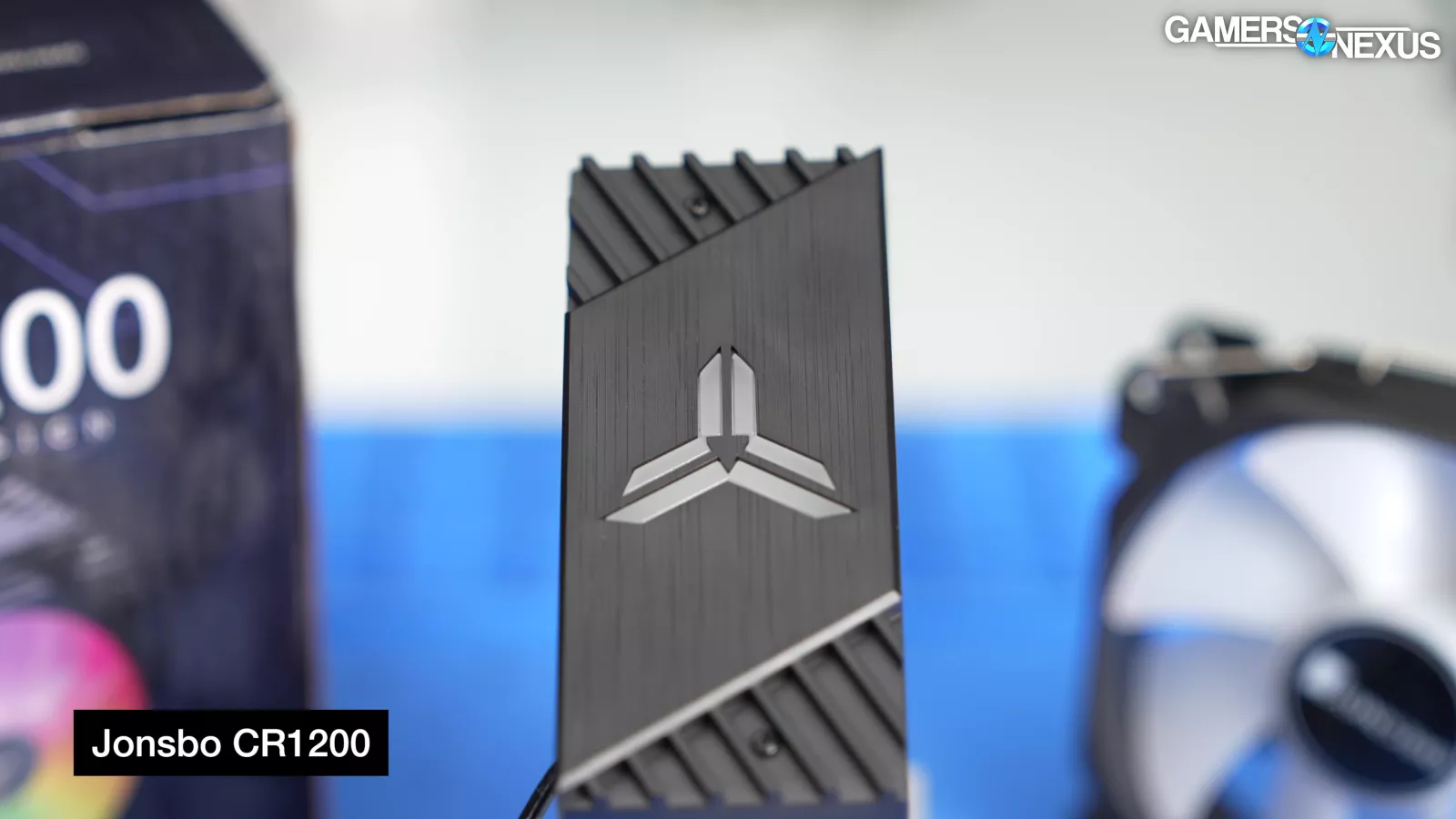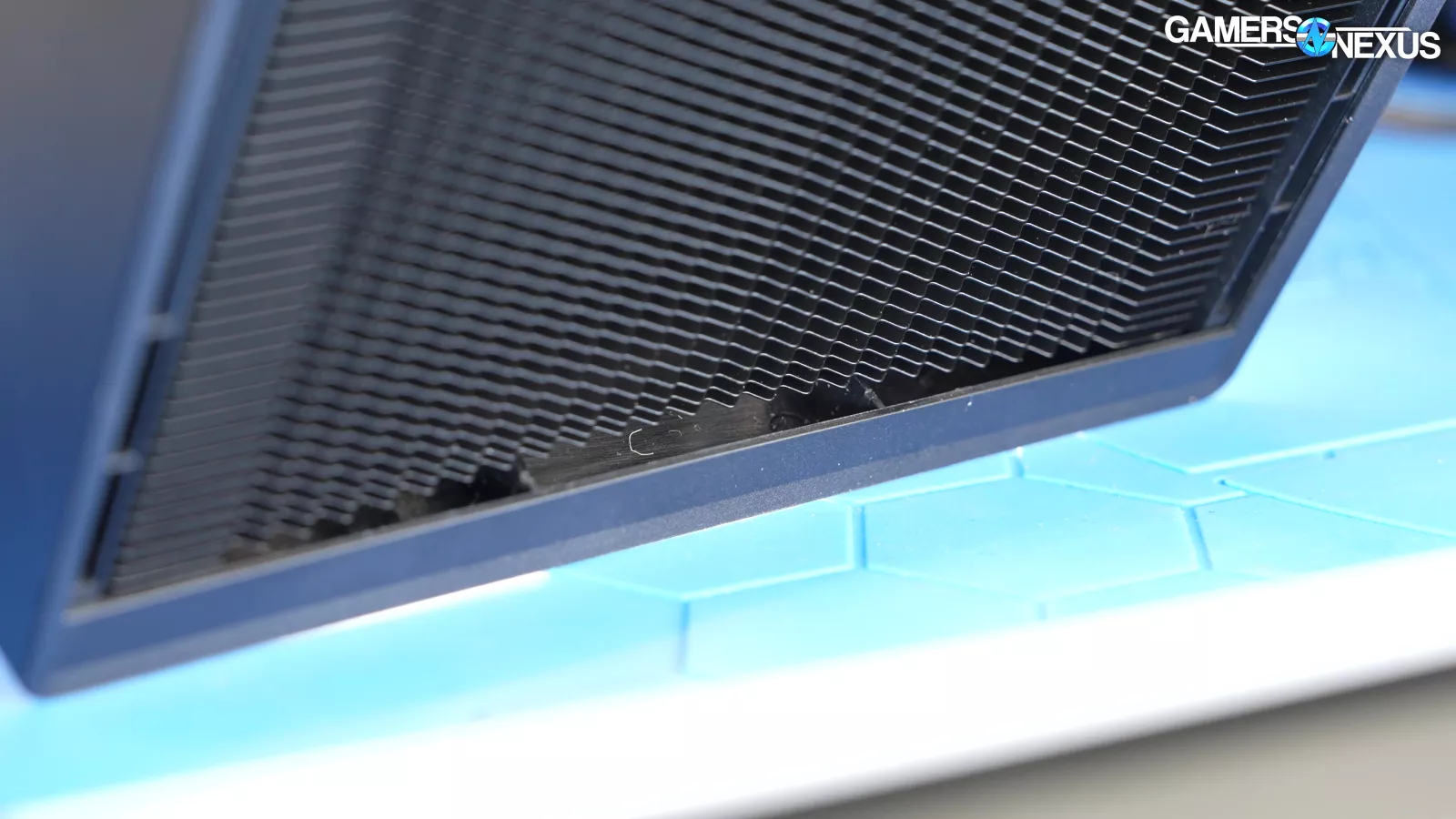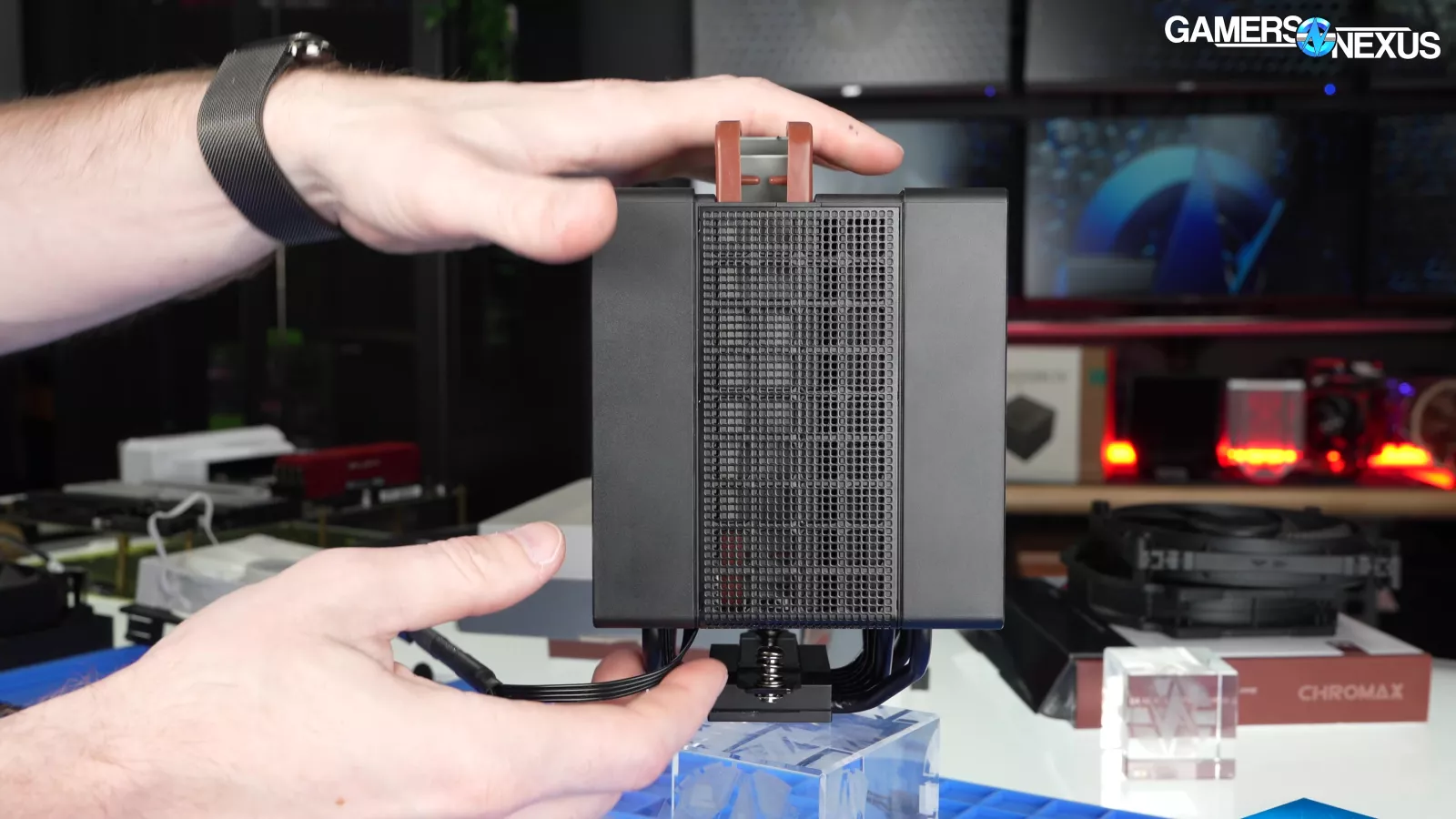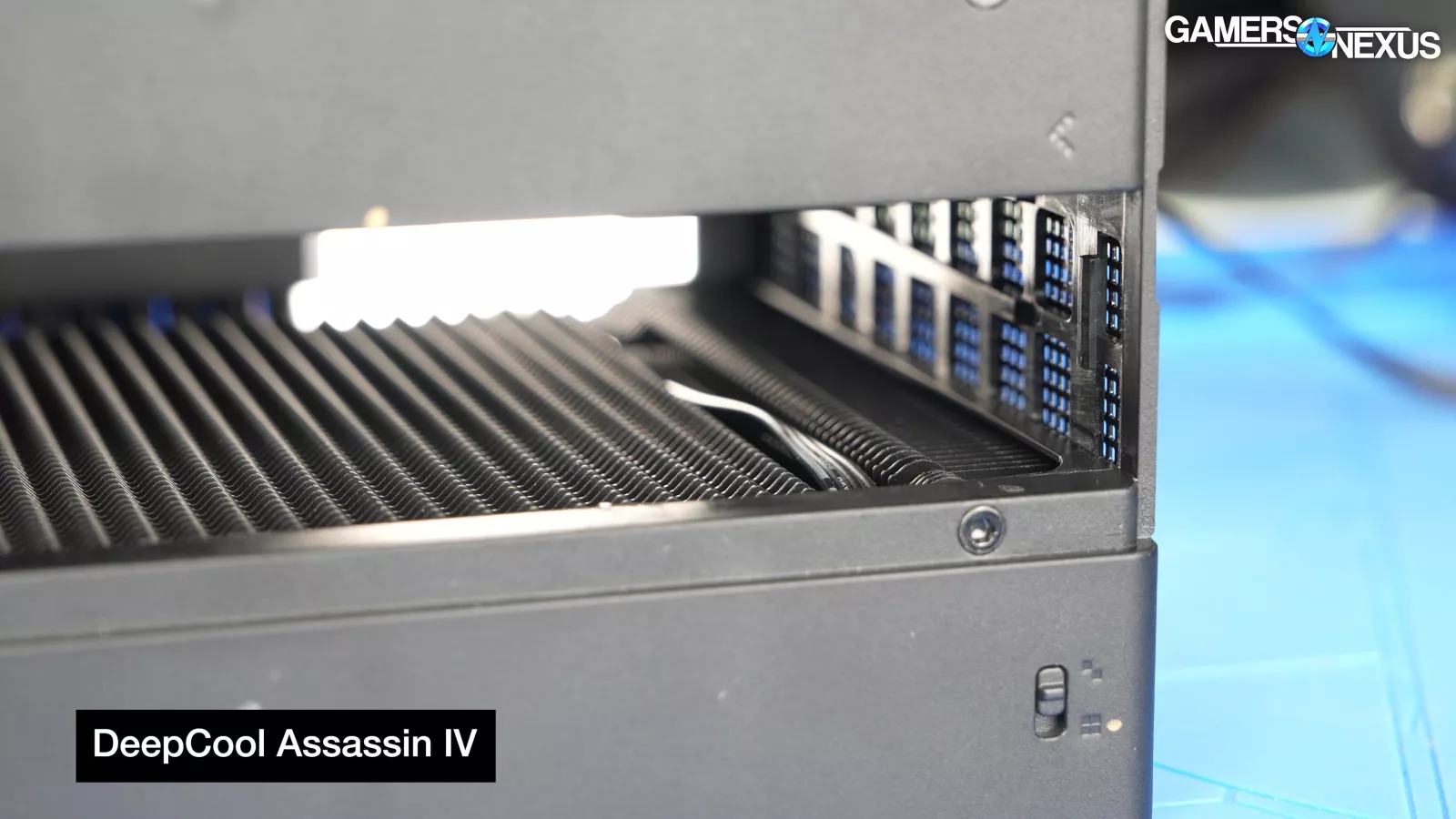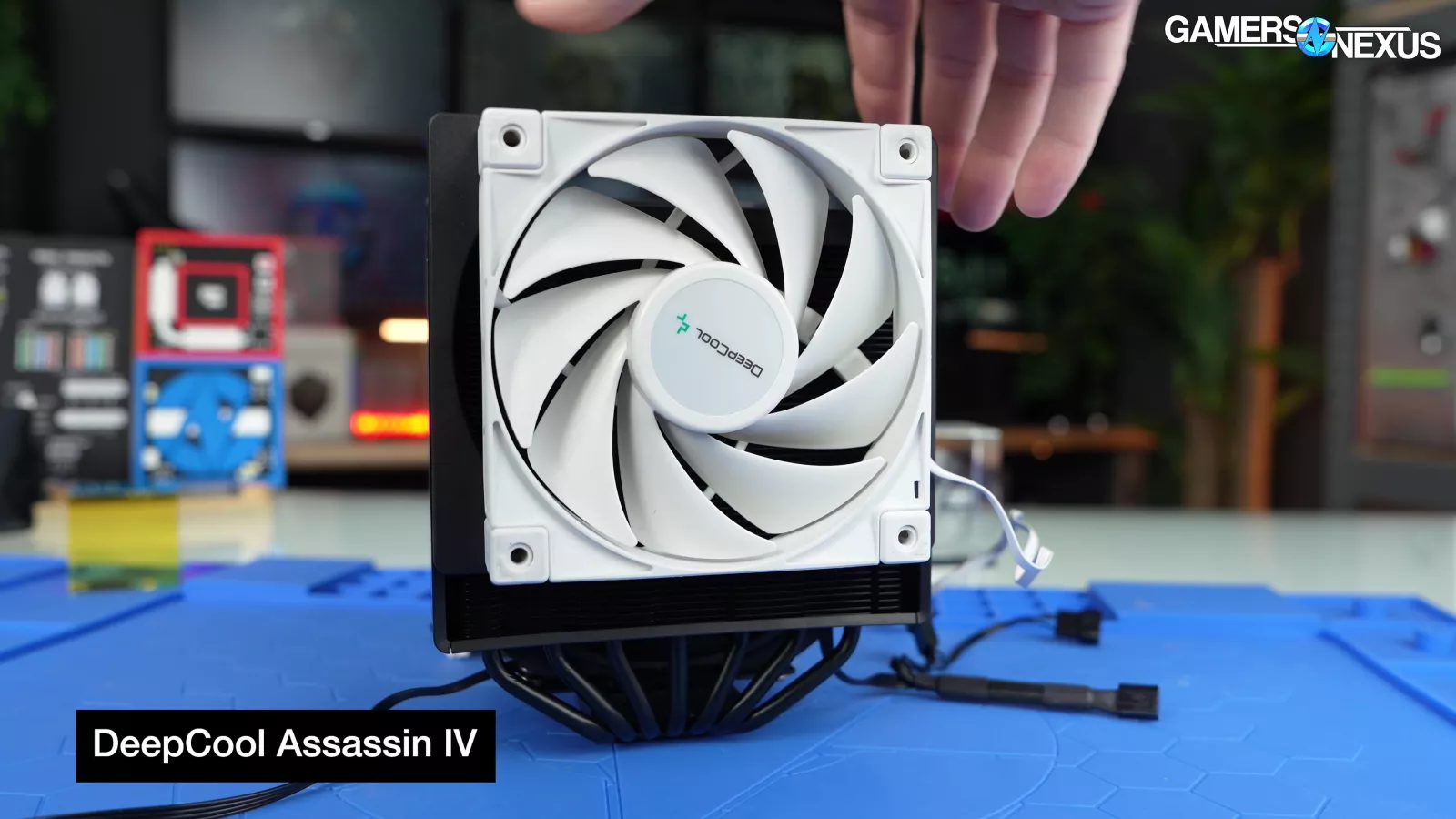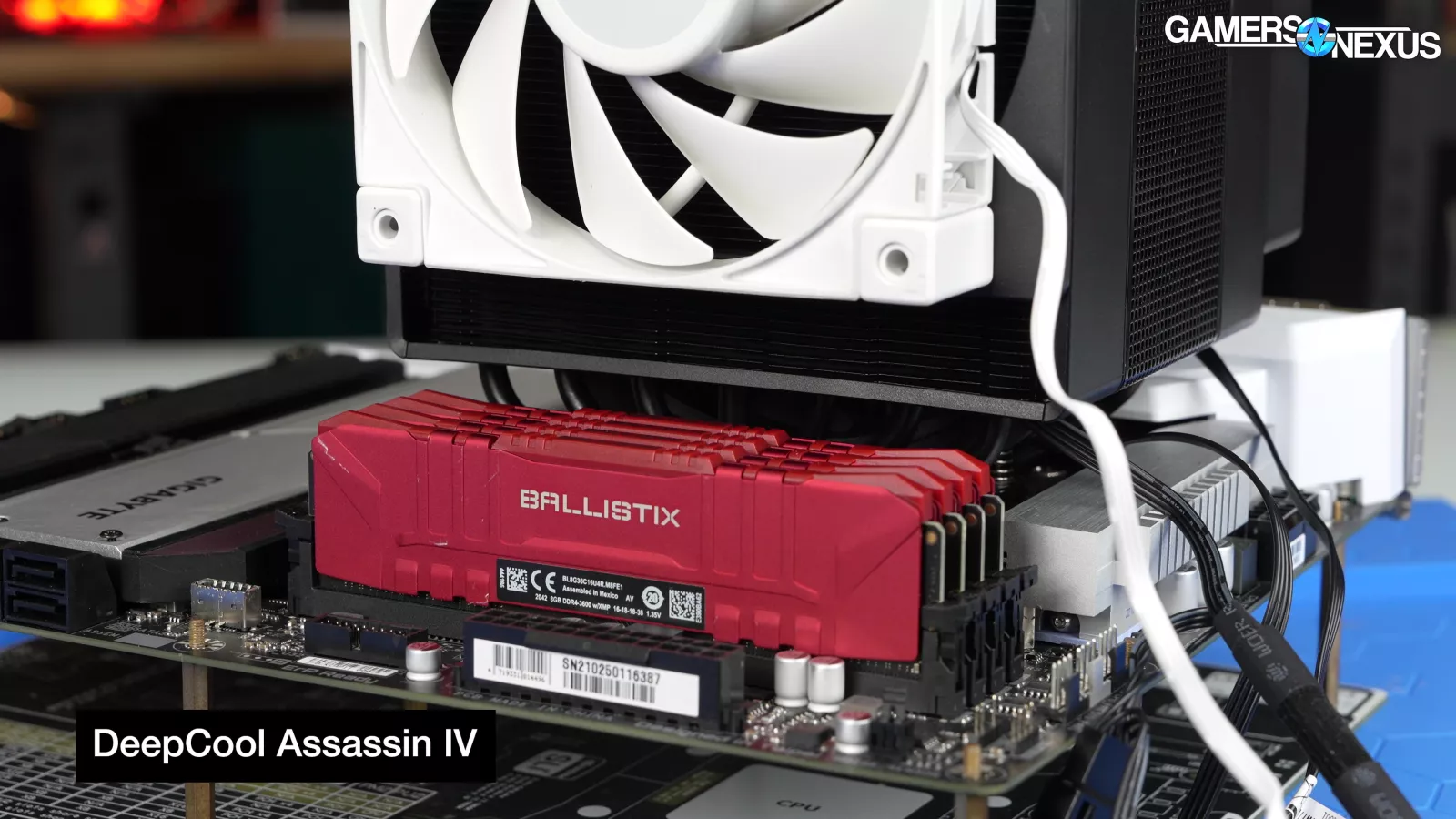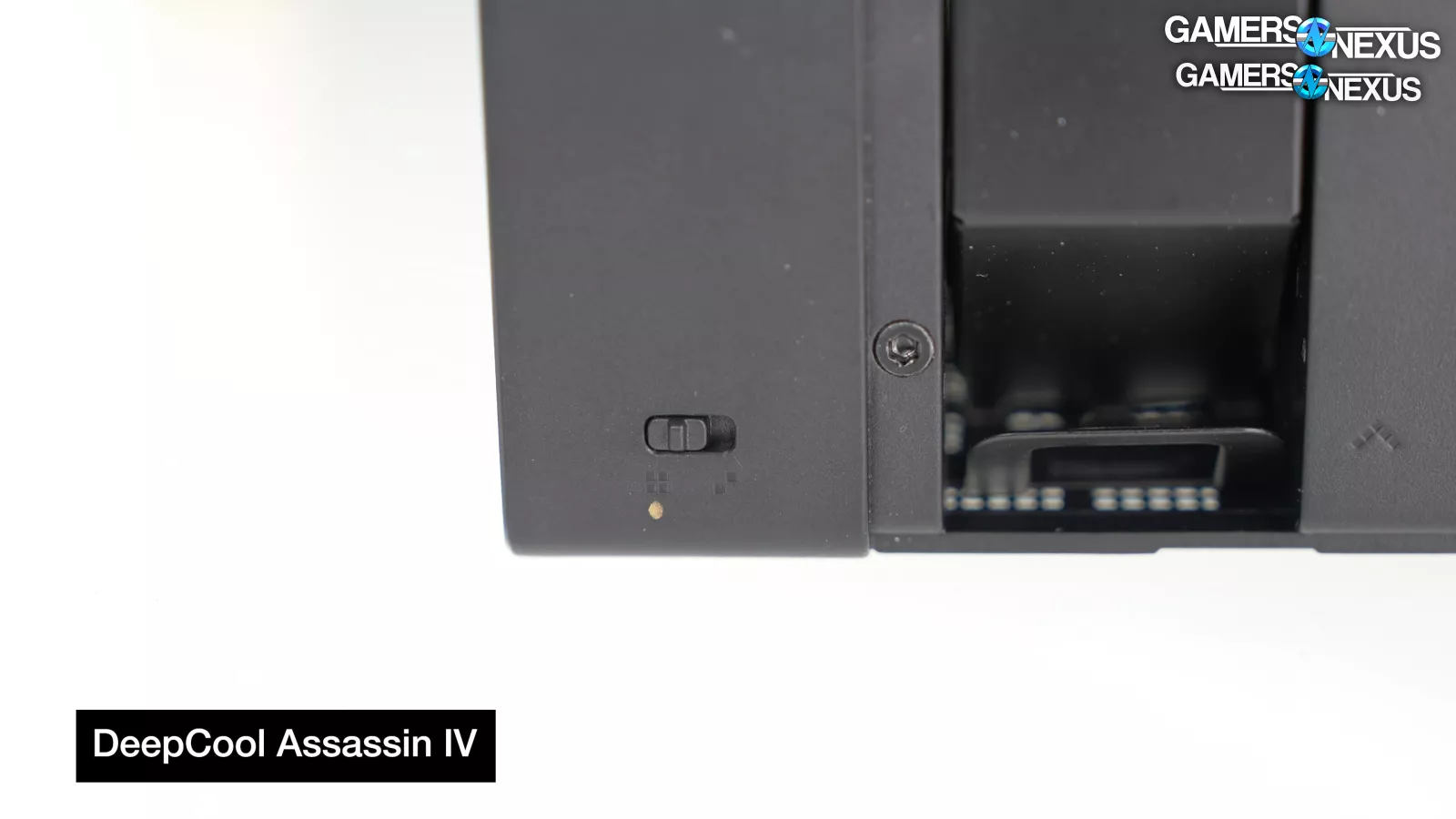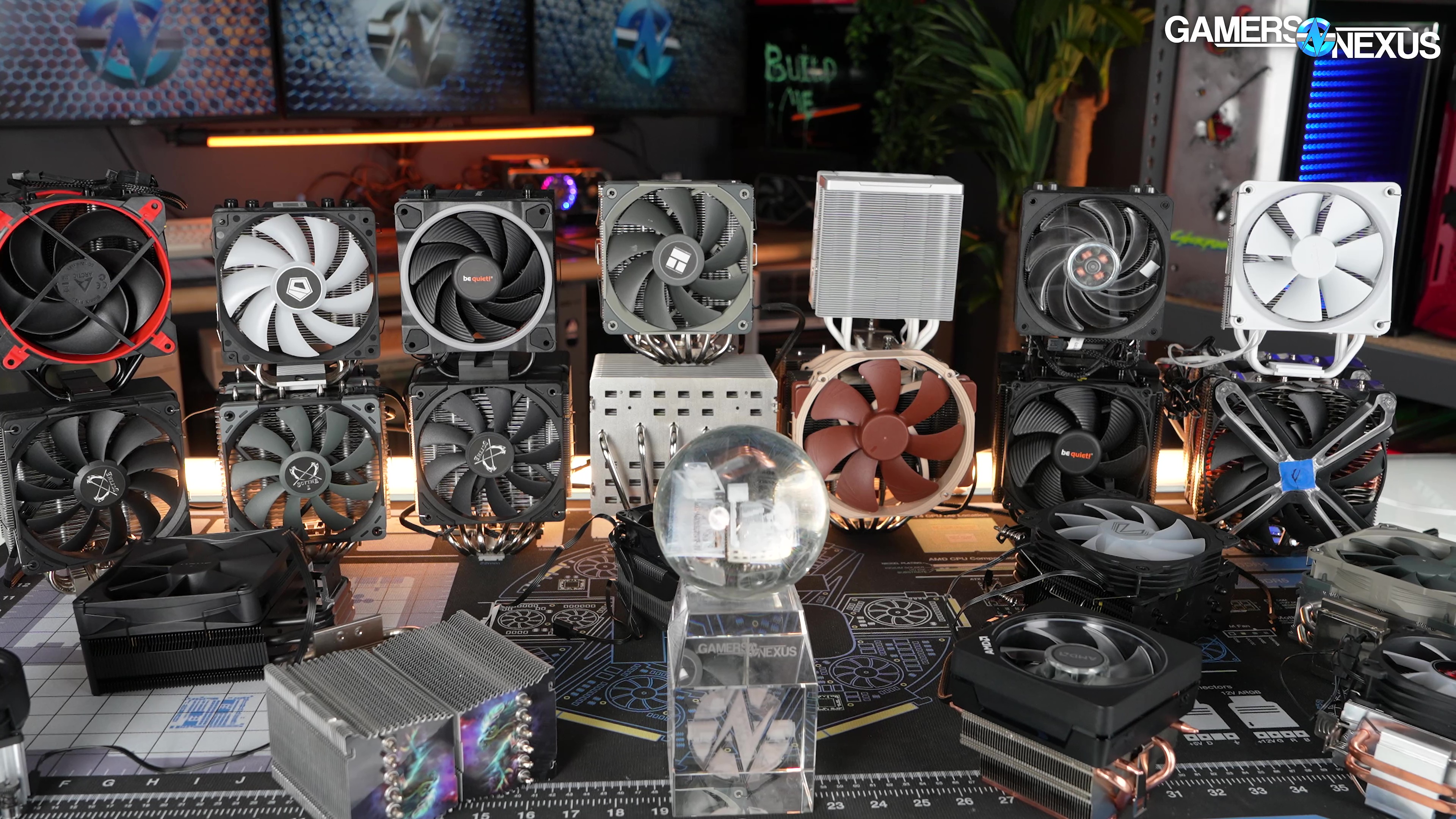
We provide awards for the best air coolers for CPUs in 2023 and beyond for thermals, noise, & more
The Highlights
- Thermalright’s Peerless Assassin 120 wins our Best Overall CPU Air Cooler award
- ID-Cooling’s SE-214-XT ARGB wins our Best Value CPU Air Cooler award
- Noctua’s NH-P1 wins our Best Thermal Design CPU Cooler award
- Jonsbo’s CR-1200 wins our Best Ultra Budget CPU Air Cooler award
- DeepCool’s Assassin IV wins our Best Mechanical Design CPU Air Cooler award
Table of Contents
- AutoTOC

Intro
We’ve been blown away by the performance and value of modern air coolers, and now we’re rounding-up the best ones that we’ve tested in the past years.
This year in particular, the air cooler market was packed with good options in all price ranges, including the DeepCool Assassin IV at the high-end, the Thermalright Peerless Assassin in the middle (with the review here), and some hangers-on from prior years have remained relevant, like the Noctua NH-P1 passive cooler.
This article is also special because it’s kind of a send-off for our test platform that we’ve done all this benchmarking on. We’ve been using this methodology for 3 years now, but it’s time to move to new hardware and methods that we’ve improved in that time. But all of these air coolers get at least one last send-off.
(Note: This piece was originally published as a video on November 26, 2023. It has now been converted as an article. The publishing date for the article reflects the date it was finalized; however, no content has been changed from the original video)
Credits
Host, Writing
Steve Burke
Video Editing
Vitalii Makhnovets
Camera
Tim Phetdara
Web Editing
Jimmy Thang
List of CPU Air Coolers
We have a massive list of air coolers we’ve tested recently. This set of data includes some new entries from be quiet!, NZXT, ID-Cooling, and more. We also just published these and the results in our GN Mega Charts: Air Coolers round-up. A lot of the coolers aren’t necessarily strictly from this year, but they’re still relevant today. In our upcoming, new dataset, we’ll also be looking at several of the new coolers from be quiet! and others.
Best CPU Coolers (Air Coolers)
| Award | Cooler (Original Review) | Amazon | Newegg |
| Best Overall | Thermalright Peerless Assassin | Link | Link |
| Best Value | ID-Cooling SE-214-XT ARGB | Link | Link |
| Best Thermal Design | Noctua NH-P1 Passive Cooler | Link | Link |
| Best Noise-Normalized | DeepCool Assassin IV Thermalright Peerless Assassin | Link (Assassin IV) Link (Peerless Assassin) | Link (Assassin IV) Link (Peerless Assassin) |
| Best Ultra-Budget | Jonsbo CR-1200 | N/A | N/A |
| Best Mechanical Design | DeepCool Assassin IV | Link | Link |
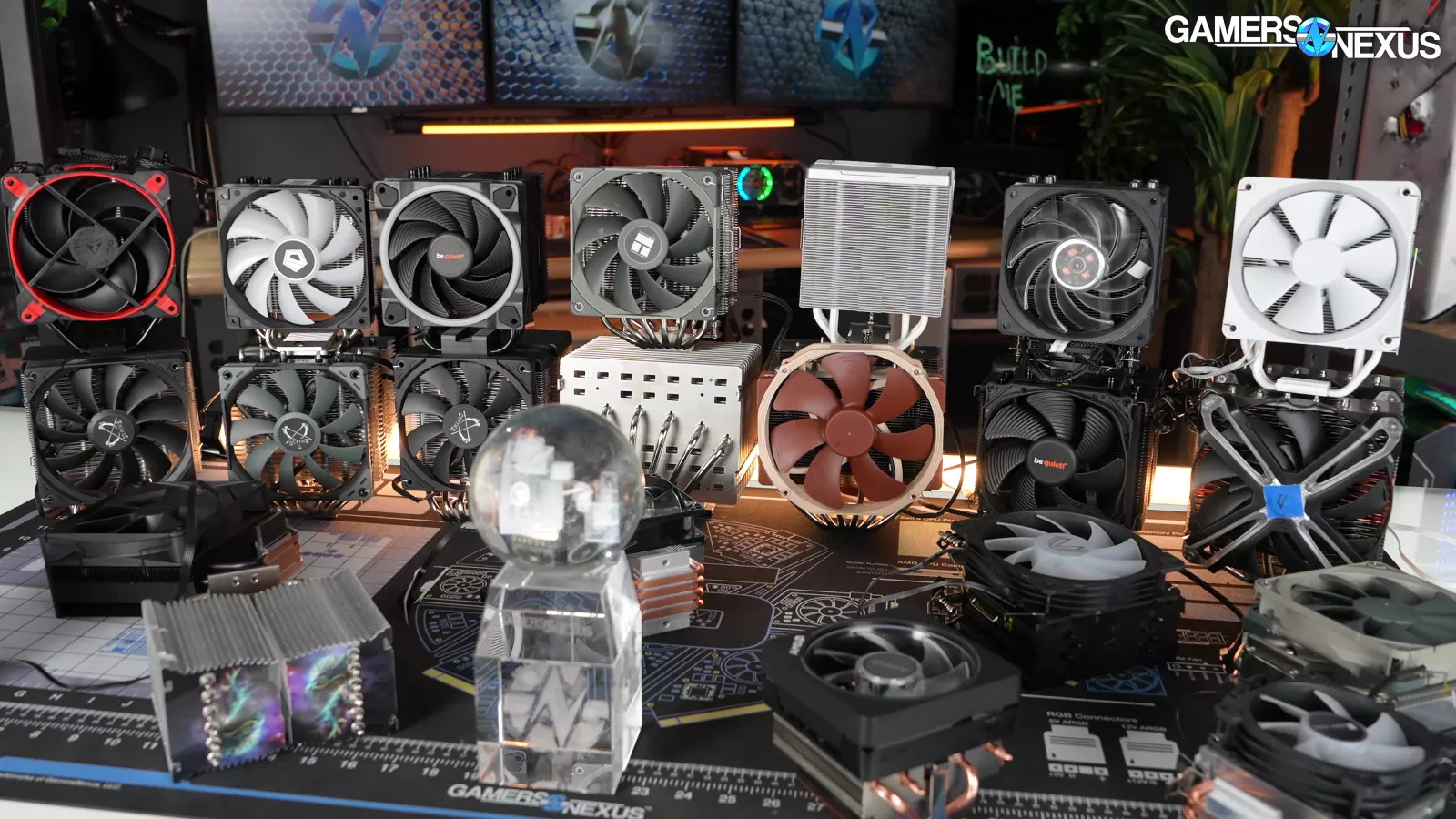
Setting Expectations
There are a lot of coolers we haven’t tested that may also be viable, but we've tried to cover a wide range of air coolers. This article is meant to provide a top-level overview to get people quickly acquainted with the best options we’ve seen. For more depth on each cooler, make sure to check out their individual reviews.
Best Overall CPU Air Cooler: Thermalright Peerless Assassin 120
Thermalright Peerless Assassin 120 | Original Review | Amazon | Newegg
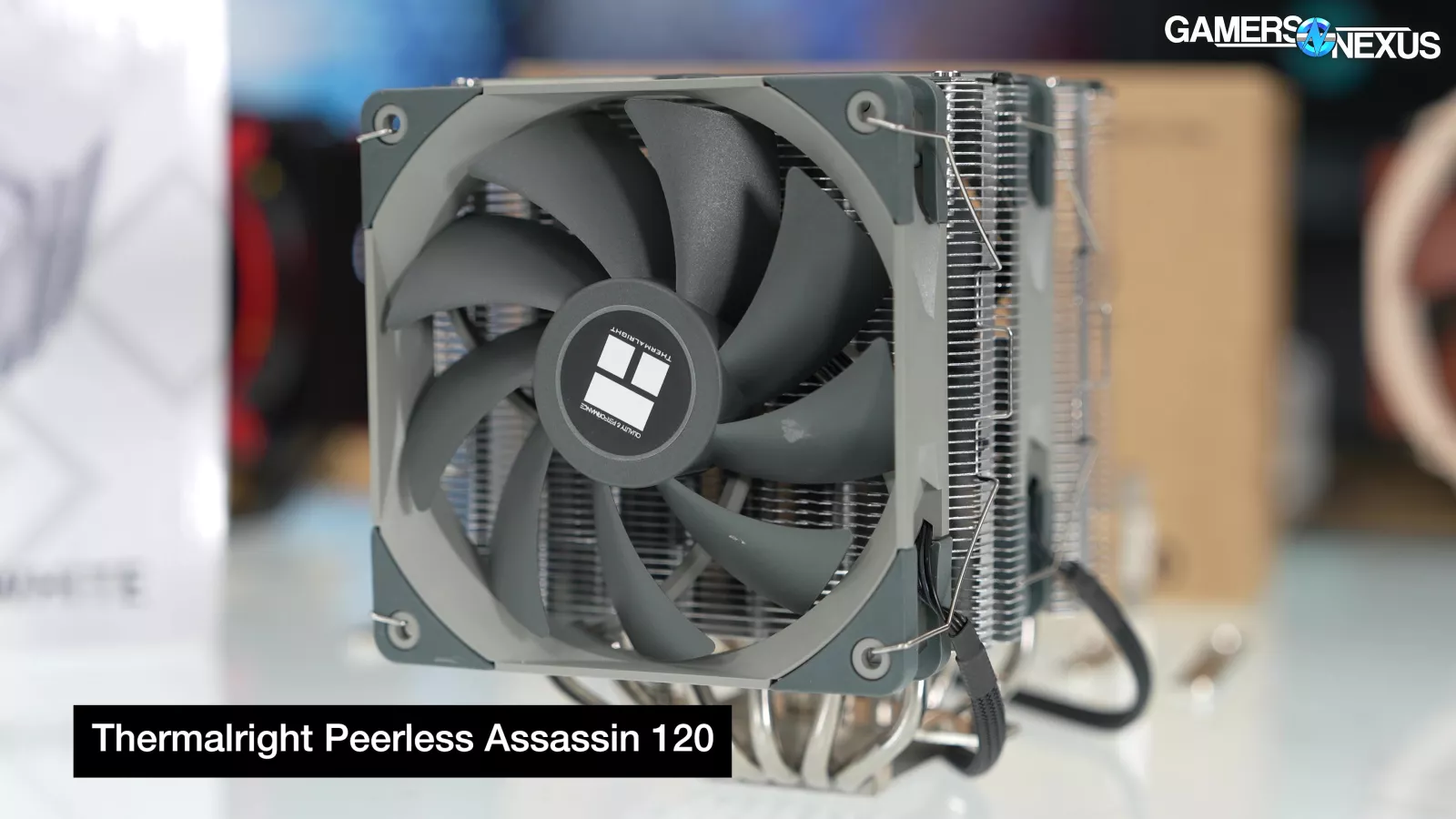
First up is the Best Overall, which is awarded for a balance of affordability or cost, thermal performance across all tested heat loads, pressure compliance with the IHS, flatness, and build quality. This one goes to the Thermalright Peerless Assassin (also available here on Newegg), which also wins another category in this story for thermals, so we’ll save most of the thermal discussion for that section.
Thermalright has been around a long time, but just recently started making major waves for affordable coolers of reasonable build quality. Thermalright put pressure on the market with its single-fan Assassin Spirit (find our review here). It has also been spun-off into other options, by pricing it at around $20-$26. The Peerless Assassin was highly requested by our audience for review, and we quickly saw why: With its price tag commonly in the $30-$40 range, it’s one of the best coolers for the money if you’re looking for air cooling capabilities that can handle moderate heat load devices. This would still struggle with infinite turbo on a modern i9, but for a 200W heat load and especially for most of AMD’s R5 CPUs and many of Intel’s i5s, this handles itself well.
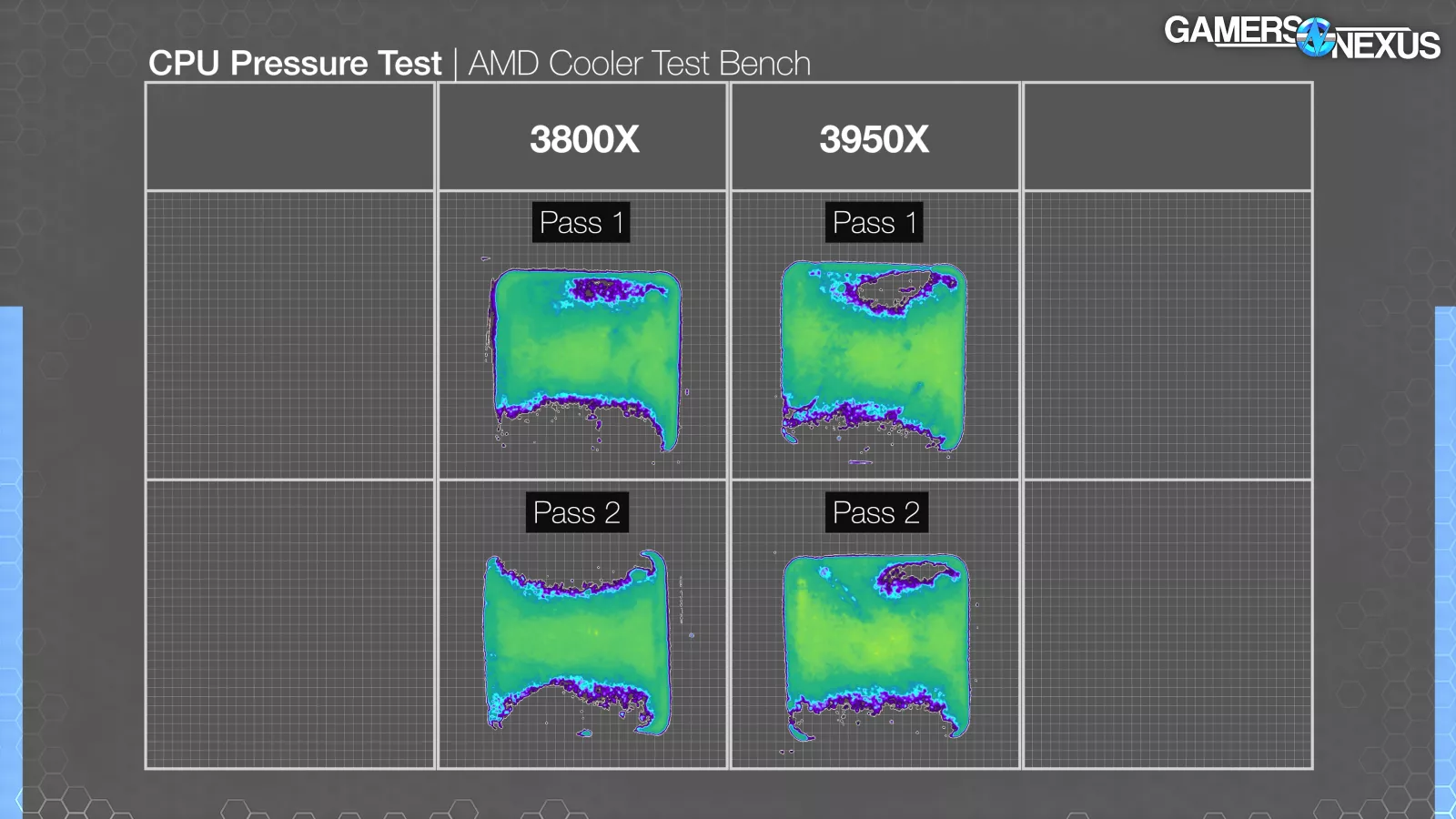
Other than its chart-leading thermal performance that we’ll talk about later, the Peerless Assassin gets this rank for its nearly perfect pressure map that we saw in our review.
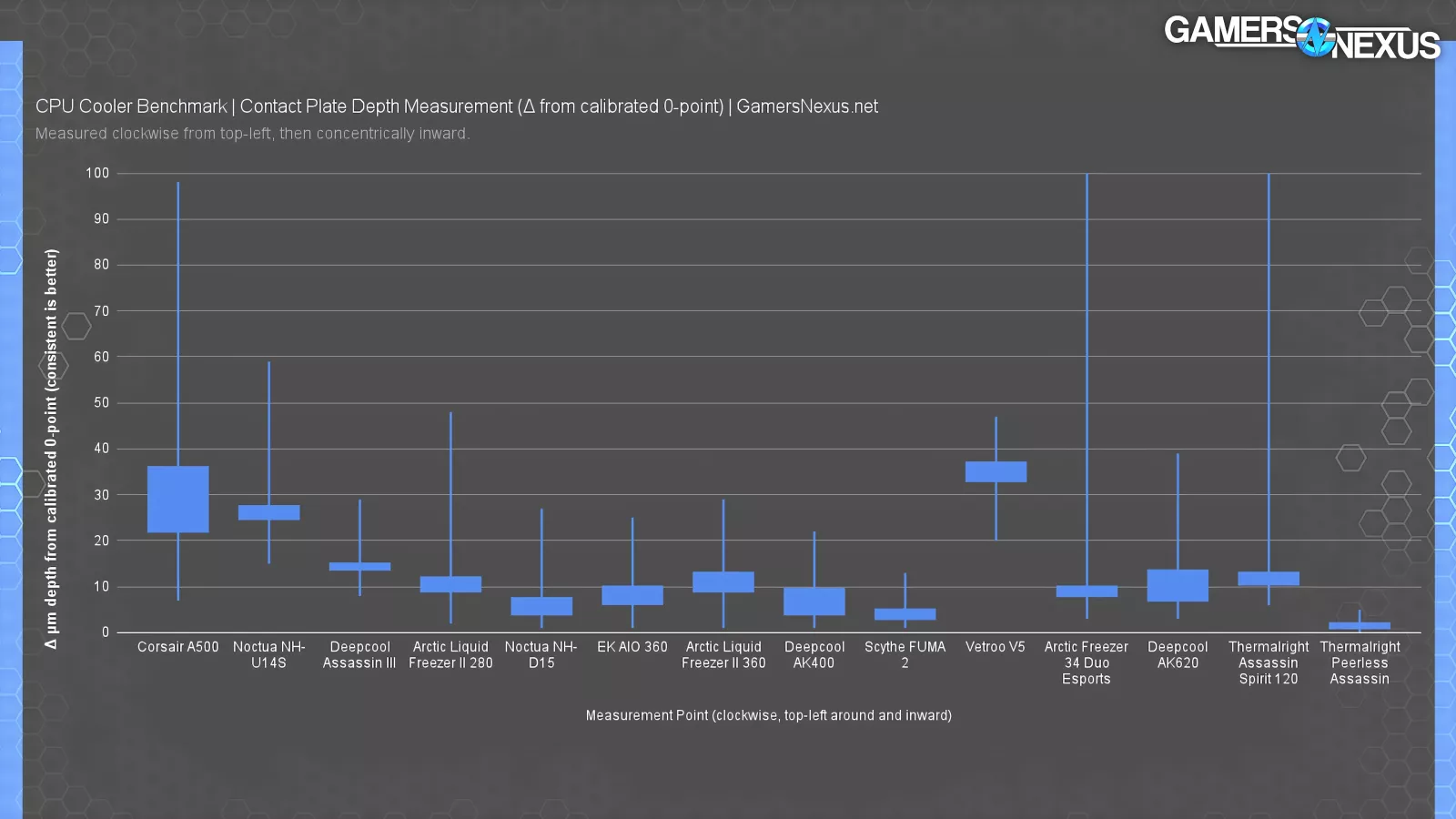
Its cold plate flatness point-to-point was also among the best we tested. That particular test is to identify point-to-point, microscopic pits or craters that cause gaps in contact, and the median measurement for the Peerless Assassin was the best we’d seen at that time.
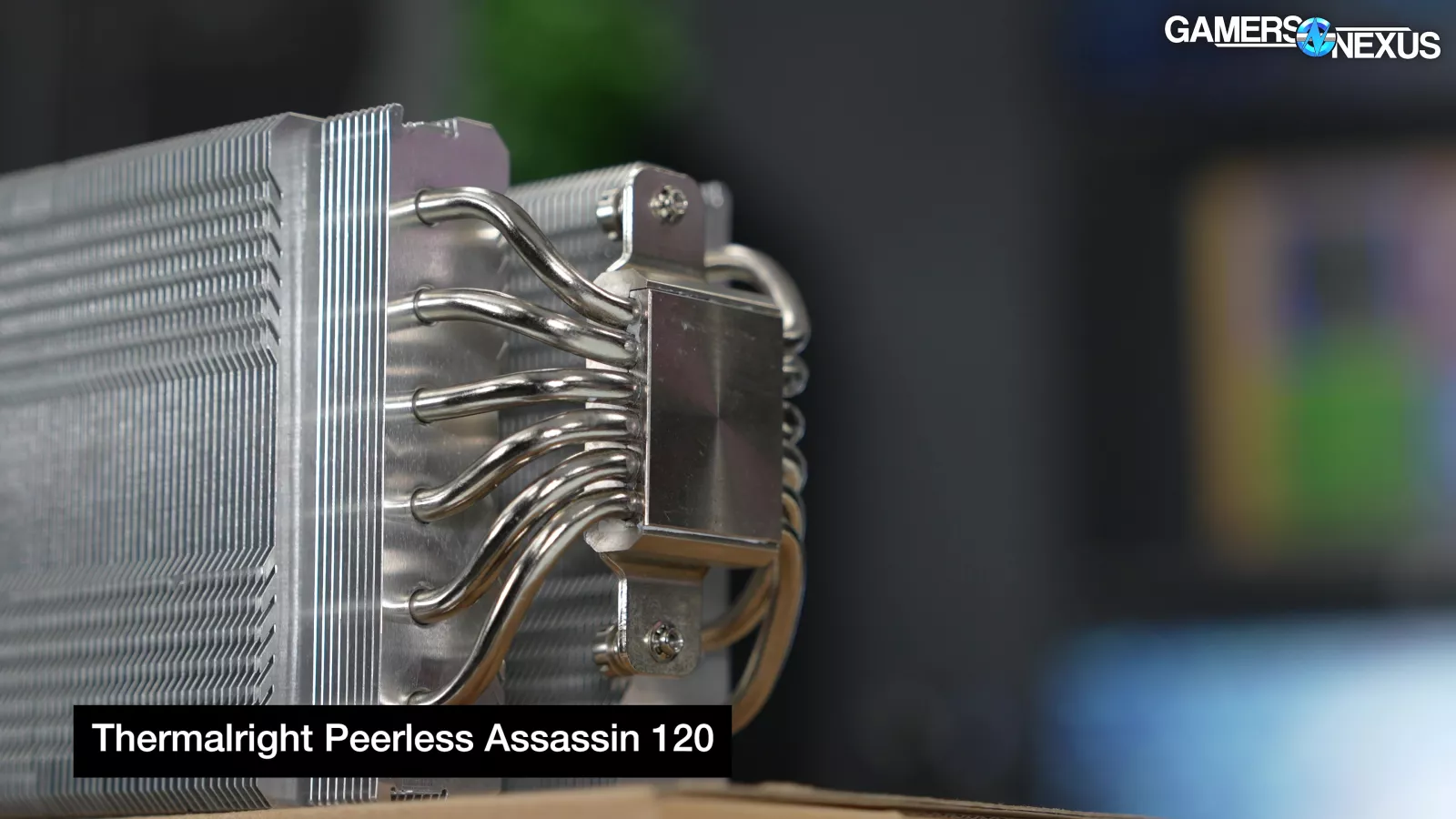
Thermalright has some minor attention to detail elements, like biasing the heatpipes toward one side to allow for better clearance of surrounding VRM heatsinks or clearance for top-mounted components.
Build quality overall also surprised us. The cooler doesn’t have the same cheap, low-quality feeling you’d get on some of the $2 coolers we’ll talk about later. Thermalright mostly makes its cost savings on the fans, the lack of LCP in the blades, and the lack of RGB LEDs. These are extremely function-focused coolers.

The mounting solution and process was straight-forward as well. Our main criticism was the pressure required by the captive springs to thread them onto the bracket, which is done better by Scythe’s newer coolers. That’s an area Thermalright could improve. The looks aren’t special, but they’re good enough for someone who’s OK with a function-first build. You could look at the DeepCool AK620 for a comparable cooler with more focus on the visuals. We’ll cover thermals more in a moment.
Best Value CPU Air Cooler: ID-Cooling SE-214-XT ARGB ($17)
ID-Cooling SE-214-XT ARGB | Amazon | Newegg
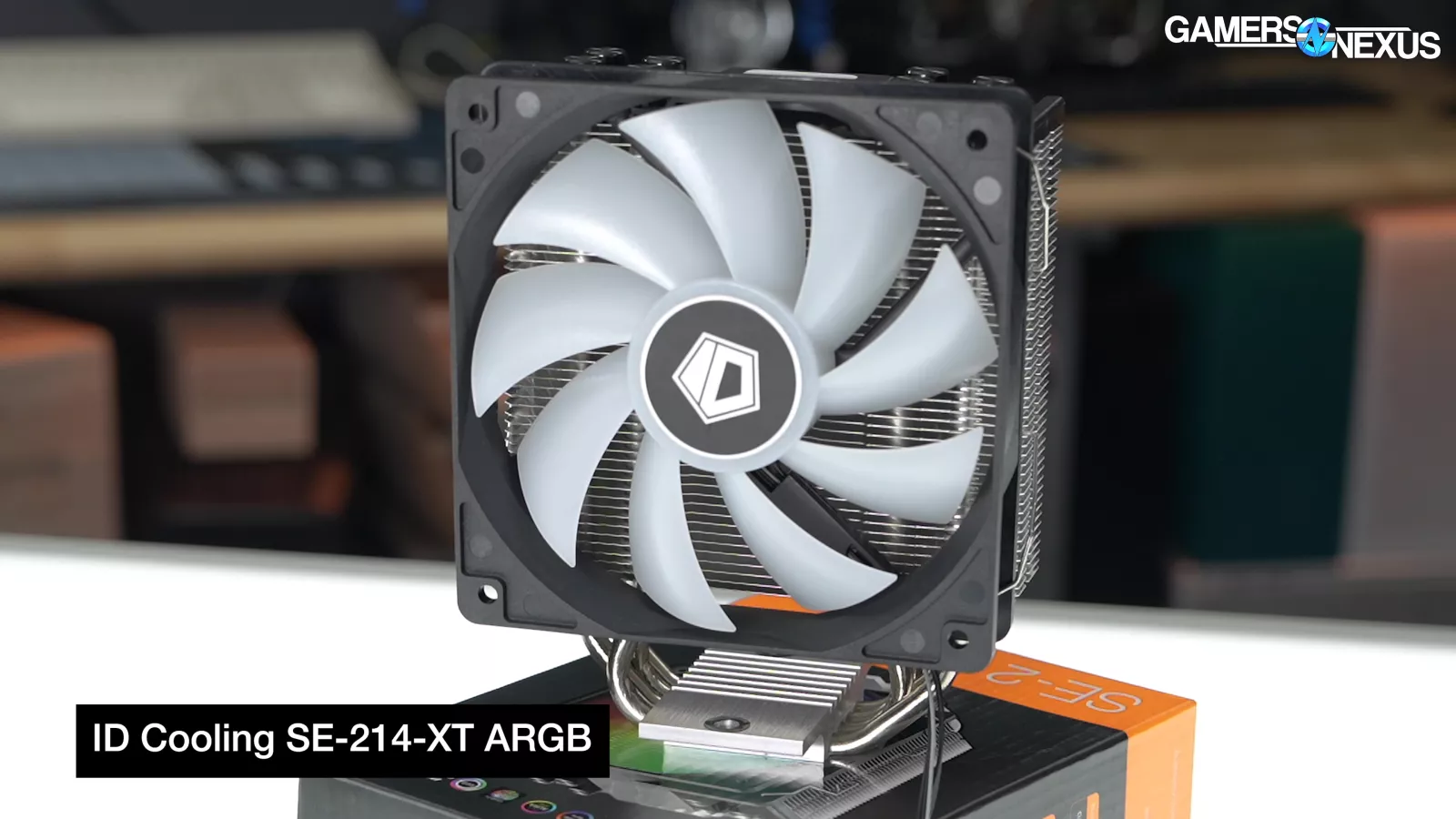
The next award is for Best Value. This category primarily considers price-to-performance. It somewhat factors-in build quality, features, and noise, but most heavily judges performance to cost. This is focused on single tower coolers - we’ll come back to higher heat load performance in the Best Noise-Normalized Thermals category. We’re looking at under 125W here. We’re not weighing build quality, ease-of-installation, or extra features much for this one.
The winner for the low heat load best value award is the ID-Cooling SE-214-XT ARGB. This cooler packs a lot of performance for its price. But at around $17, it’s worth noting that it’s not the cheapest cooler in our lineup, that would go to the Jonsbo CR-1200, which we'll talk more about down below. ID-Cooling has been around for about a decade now, but recently has made a big push with these air coolers.
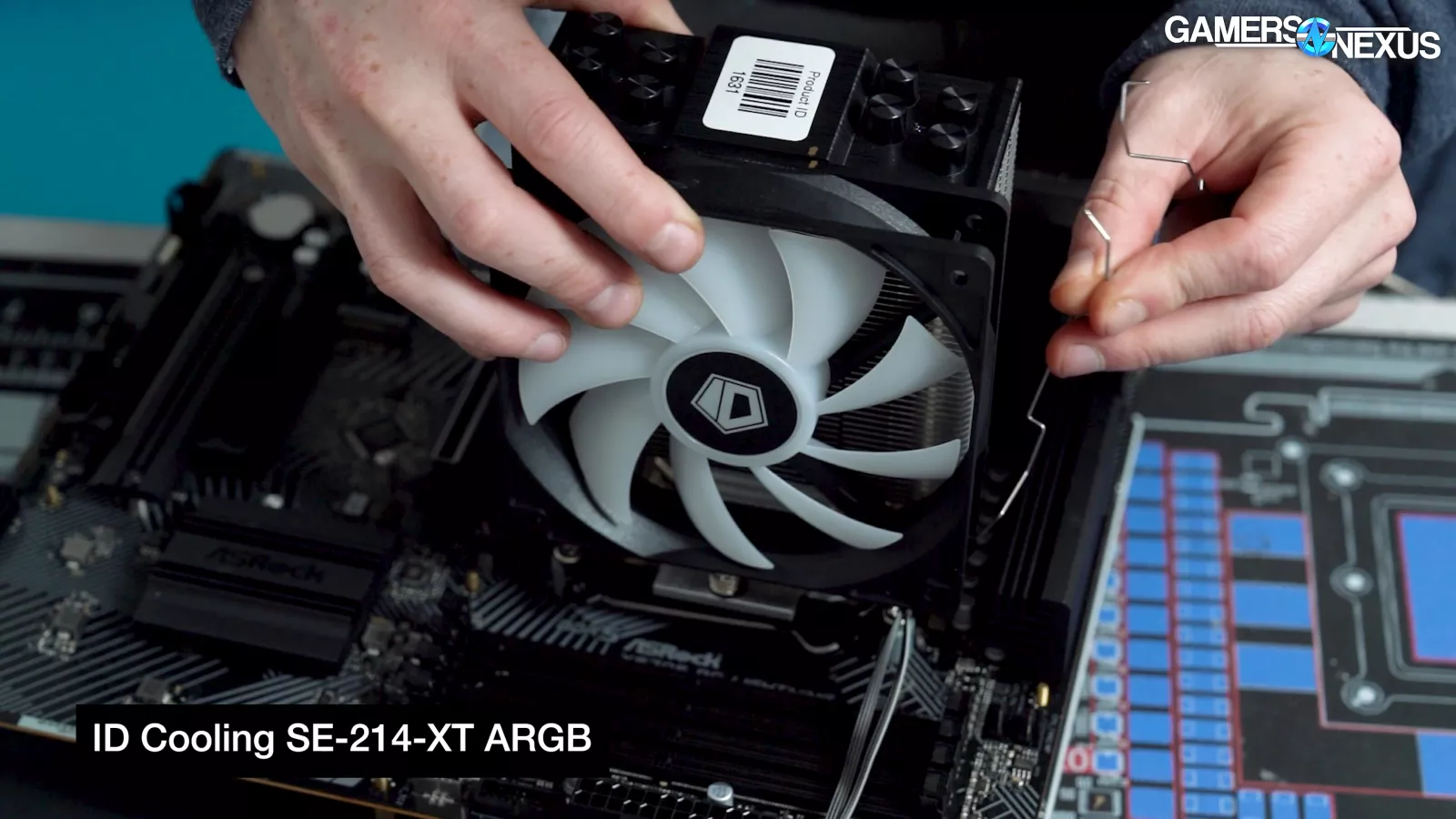
The SE-214-XT ARGB includes a single 120mm fan -- it’s not high quality, but it’s fine for the job -- and simple, standard metal clips secure it to the heatsink. The cooler is also about as short as a 120mm cooler can be, benefiting from a narrow tower that allows it distance from RAM.

The cold plate has 4 direct contact heatpipes without a nickel plated base and uses a 2-point contact mount to secure it to a pair of 4-point brackets. There’s not much in the way of looks: ID-Cooling has an RGB fan, a black top plate, some black caps for the heatpipes, and that’s about it. The cooler really isn’t anything special, but that’s the point: it’s affordable while still being widely available.
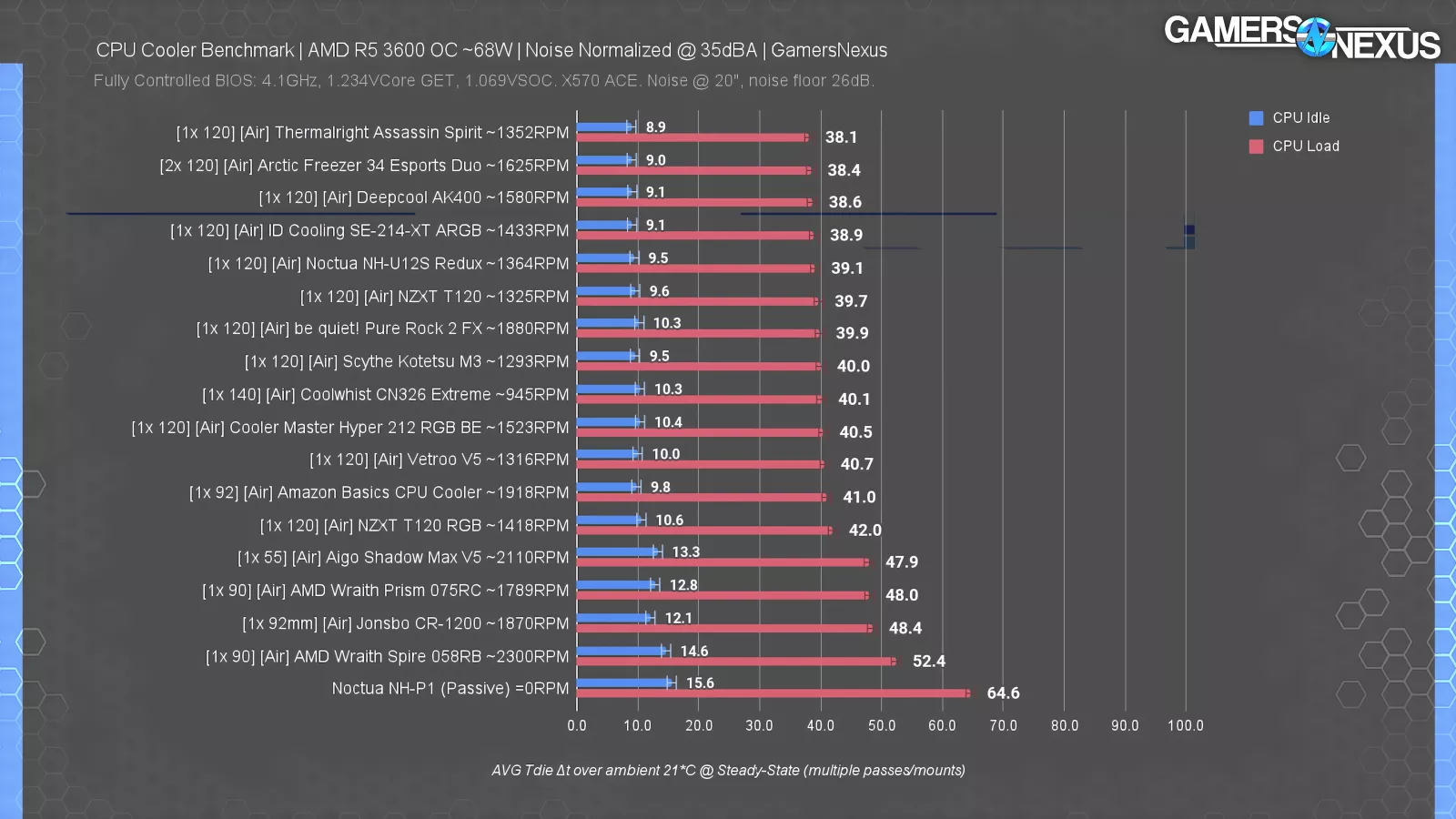
In our 68W R5 heat load at 35dBA, the ID-Cooling 214-XT was just behind the more visually refined DeepCool AK400 and Esports Duo coolers, and not distant from the single-fan Assassin Spirit.

At 123W and 35dBA normalized, the same cooler was again behind the AK400 and Assassin Spirit, although it left about 5 degrees of room between itself and the Peerless Assassin. It’s not good enough for high heat load CPUs, but overall, the results are good here.
The ID-Cooling SE-214-XT ARGB impressed us, not only with how its name feels like an onomatopoeia, but also its cooling for the price. And the installation is good, too.
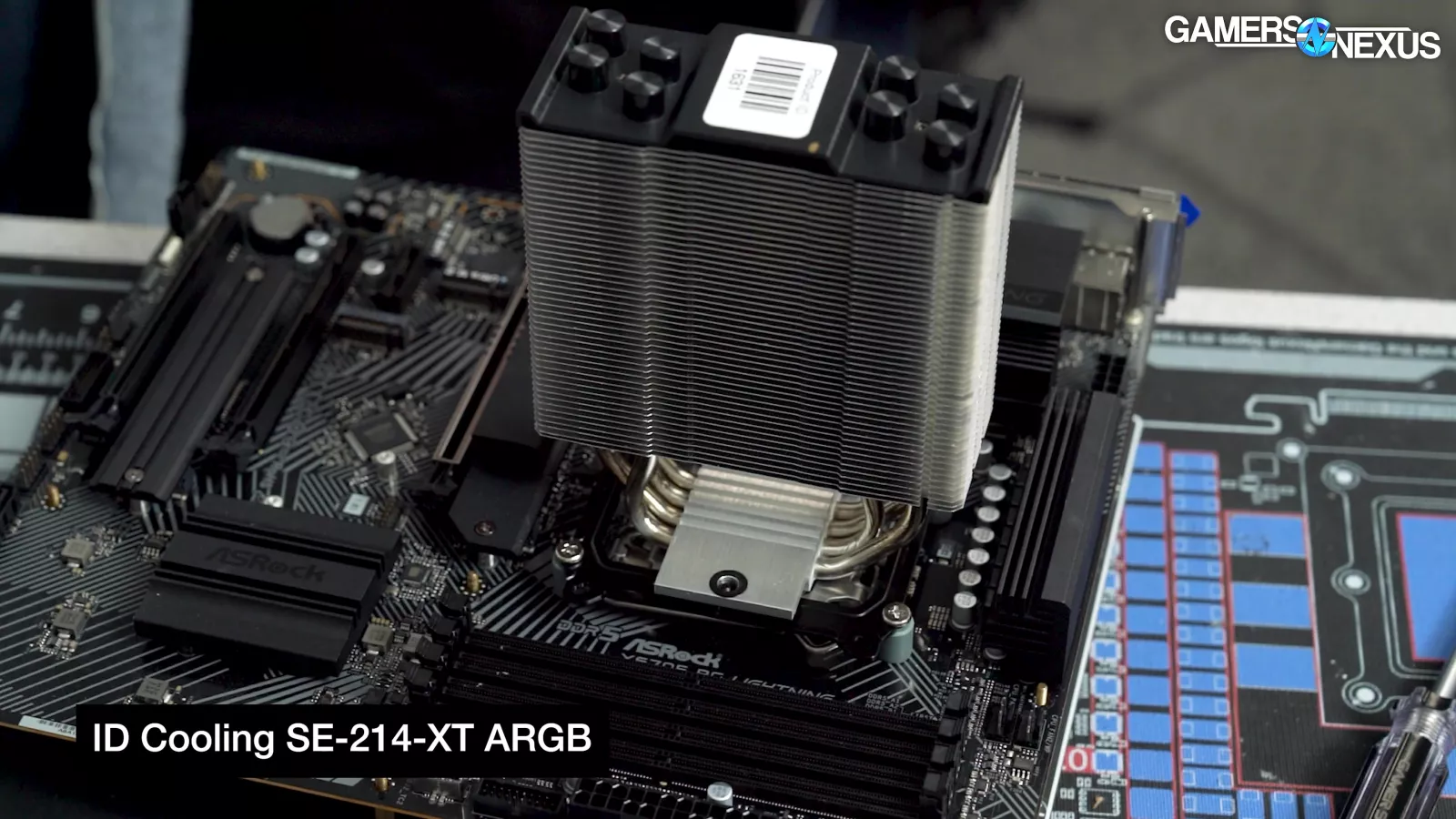
And that’s something we want to recognize: The ID-Cooling SE-214-XT has incredibly straight-forward, simple, and secure mounting. It’s nothing advanced, but ID-Cooling is at least using the same approach that most of the $30+ coolers use, rather than leaning on AMD’s clip-based mounting solution. The AMD stock clip mount is passable, but it has some severe weaknesses in pressure distribution in the non-clip sides and also is just more prone to ripping the CPU out of the socket and at an angle when being removed, especially for someone not expecting it. ID-Cooling’s mount is among the easiest on our list today and is overall trouble-free.
Best Thermal Design CPU Cooler: Noctua NH-P1
Noctua NH-P1 | Original Review | Amazon | Newegg
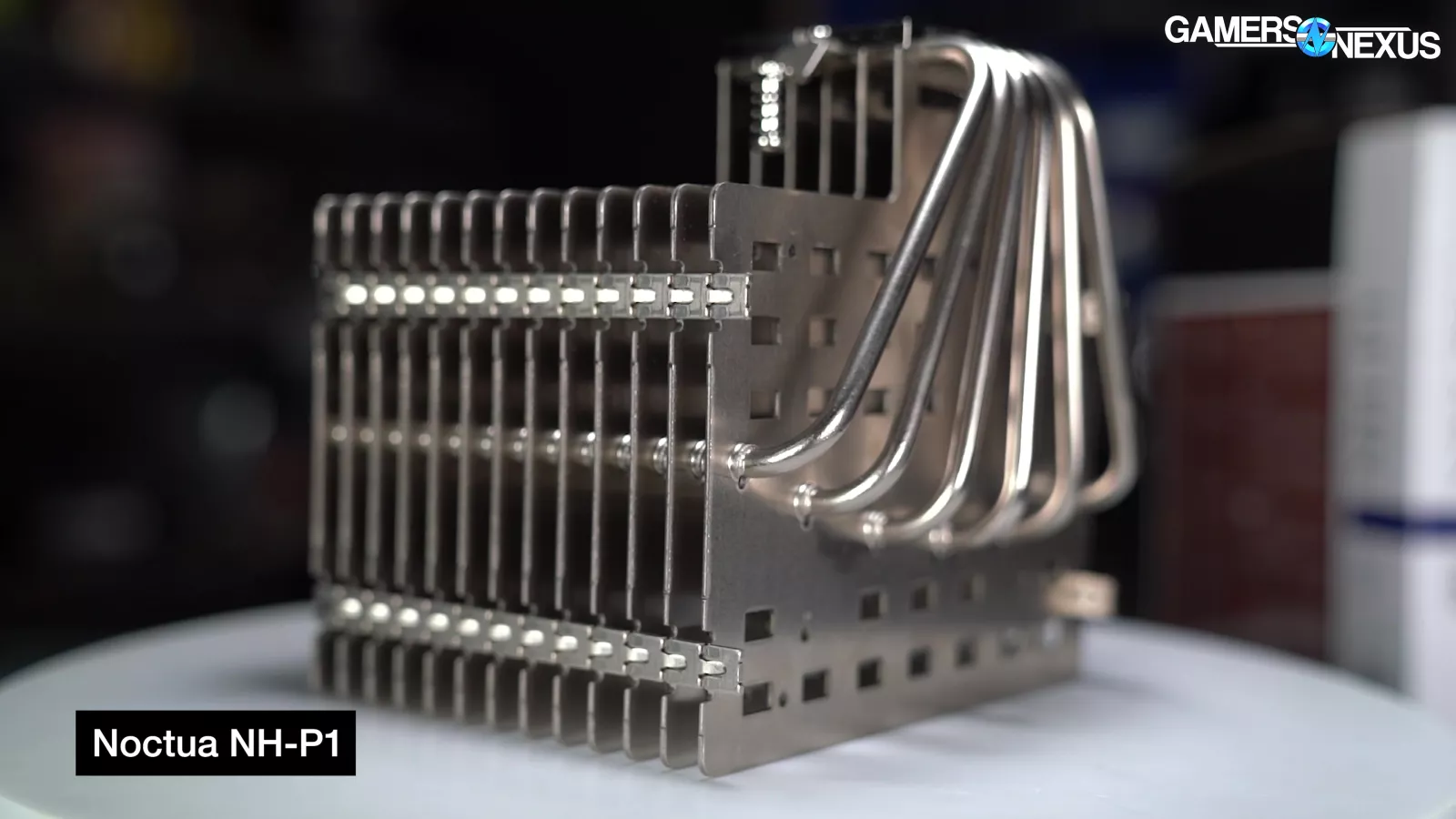
The next award is for Best Thermal Design. This one is given irrespective of cost or value, and instead focuses solely on what the cooler is trying to achieve thermally.
This one easily goes to Noctua for its NH-P1 passive CPU cooler. We use this cooler in two of our acoustic chamber test benches that we’ve been ramping up: One is on the GPU acoustics test bench, another is on the data logging bench for the acoustics room. We used these because we needed something that made 0 noise so as to avoid influence on results, but also something that could handle moderate heat load from the test applications. If we think it’s good enough for those use cases, that means it already went through heavy consideration.
We’ve been incredibly impressed with the cooler’s capabilities for a fanless solution. Passive coolers aren’t easy to make and involve a lot of hurdles to design. You can’t brute force an inefficient design with fans, making them more of an engineering challenge.
Unlike many of these dual-fan and single-fan solutions we’re covering today, Noctua couldn’t work with thousands of existing prior products on the market and couldn’t re-use and tune its own more standard heatsink designs. A good passive heatsink requires an entire, ground-up approach to design.
Coolers like this have a lot of considerations: Noctua went with fewer, thicker fins and spaced them out more, which helps give space for the air to escape passively. A more accurate descriptor for this would be “cooling plates” rather than fins, given their size and design. The spacing is designed to limit heat trap while maximizing both surface area and mass.
Noctua also cut slats through the cooler. This is also to help the air find its way out of the cooler naturally, as an orientation that causes the plates to run horizontally would create an inefficient route for air to escape through the far sides. By cutting holes through it like this, Noctua provided additional paths for the air to escape.
We actually showed this in operation in our 2021 review of the cooler, where we took Schlieren photography using a parabolic mirror, a razor blade, and a light.
This was the result. This imaging shows the air density gradient across the image. You can see how in an orientation with the plate openings upward, the air finds its way out of the cooler in an almost conical pattern. You can see the air clinging to the plates to find an exit, demonstrating in a practical sense why all that spacing between them is helpful. This is an instance where heat rising is a critical consideration for design, as opposed to something with a fan that can overcome the relatively slow rate of heat rising.
Noctua’s engineering wasn’t just on the passive cooling, though. Our pressure testing found that the NH-P1 had phenomenally good pressure distribution across the IHS overall, with only a few gaps. Every aspect of design matters when there isn’t a fan, so even pressure helps efficiently transfer heat to the cold plate.
Flatness was also excellent in the NH-P1, where we found its point-to-point range in the median was relatively tight together, indicating a consistent surface finish with minimal pits or craters.
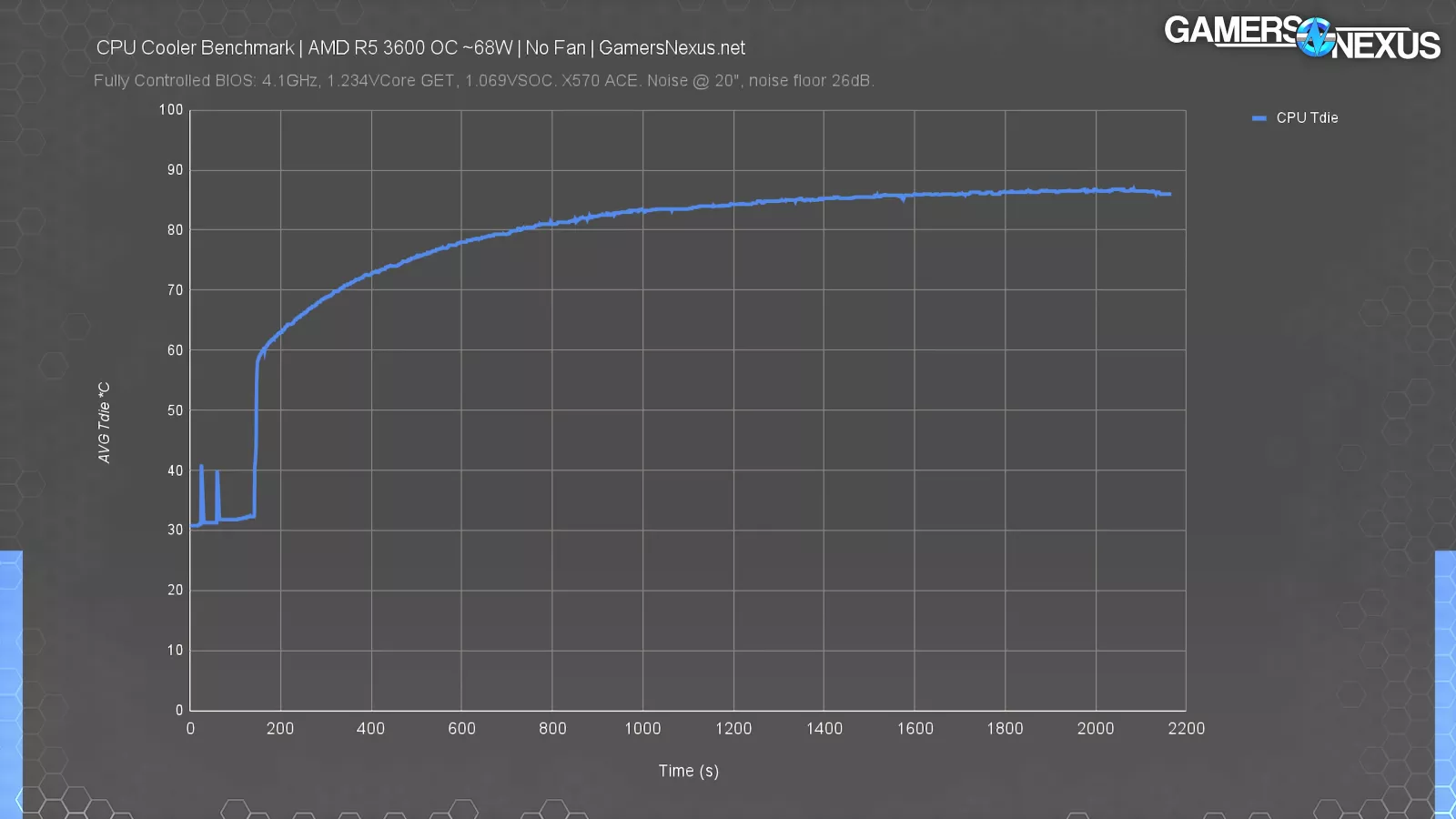
Noctua is also using a 6-pipe design to maximize the coverage through the cold plate. That and the combined surface area and mass make the cooler slow to ramp to steady state -- and that’s a good thing. You can see that it took around 25 minutes to hit the peak steady state values in our original 68W heat load test.
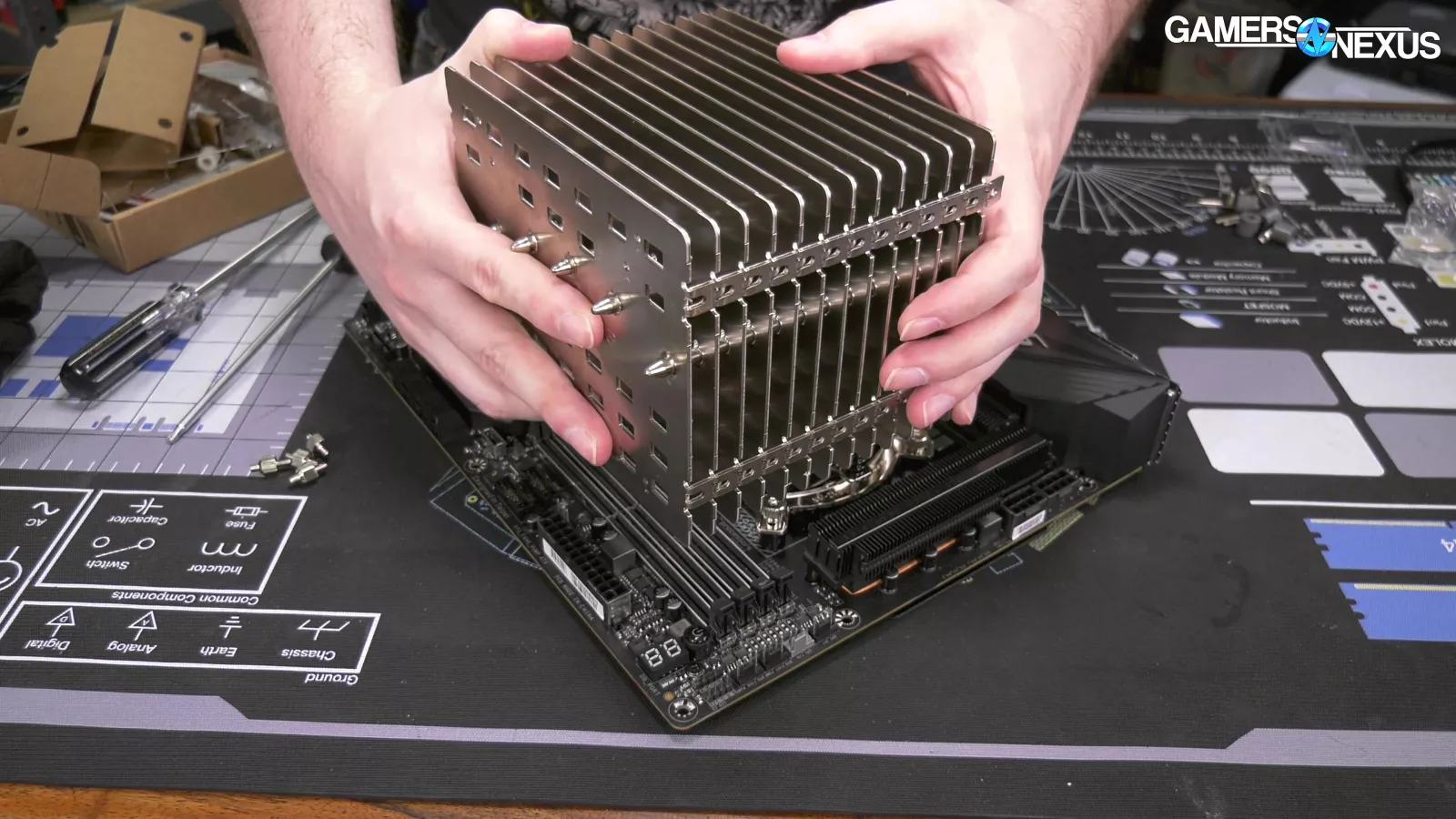
The cooler is straight-forward to install as well. Its biggest downside is size, so you’ll need to plan fitment of everything.
Thermally, these would do great with lower heat loads. Our original testing had the P1 throttling but technically running at 123W, or more than acceptable with a 68W R5 heat load. It held about 65 degrees there. Noctua has a helpful page on its site showing CPUs where it judges performance. We’ve done some validation on this and largely agree with it.
If you need a passive cooler for a home studio, a voice over setup, acoustic testing, or just because noise bothers you, we highly recommend the Noctua NH-P1 for CPUs with a heat load it can manage. You can always strap a fan to it if necessary to give both 0RPM and high load options.

Best Noise-Normalized CPU Air Cooler
DeepCool Assassin IV | Original Review | Amazon | Newegg
Thermalright Peerless Assassin 120 | Original Review | Amazon | Newegg

Our next category is for Best Noise-Normalized Thermals. Or in other words, “best out of the box thermals.” There are 3 heat loads we’re awarding this one for. At 200W, this award is taken by both the Assassin IV and the Peerless Assassin. At 123W, this award is once again taken by the Peerless Assassin.
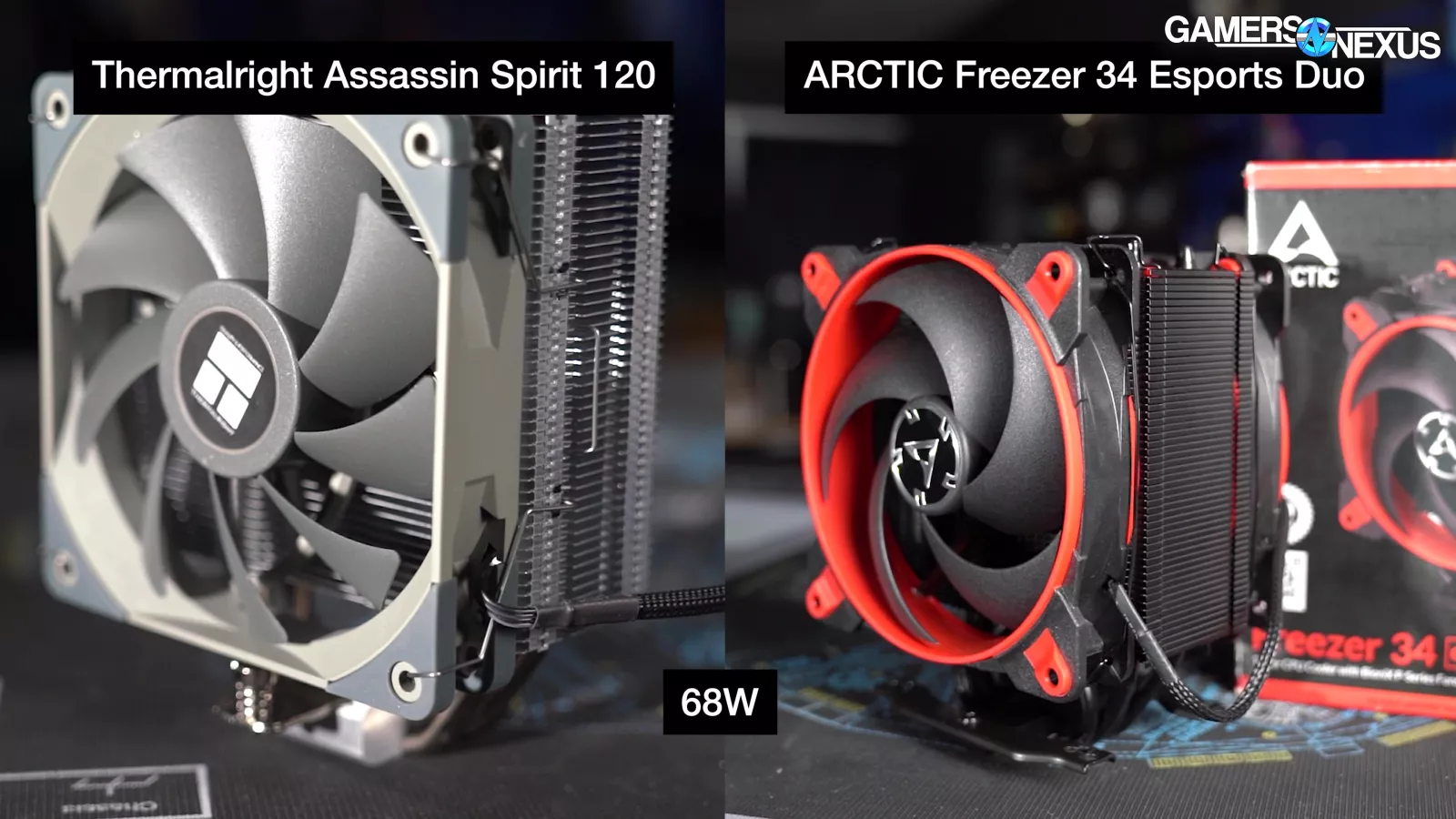
At 68W, where we don’t run the highest-end coolers since it’s not a heavy enough load, this one is taken by the Assassin Spirit -- apparently assassins really hate heat -- and the Freezer 34 Esports Duo.
This one is a simple ranking of thermal performance. Using the stock fans, we normalize everything to the same 35dBA floor at a 20” distance (we’re changing this going forward to move to our new acoustic chamber).
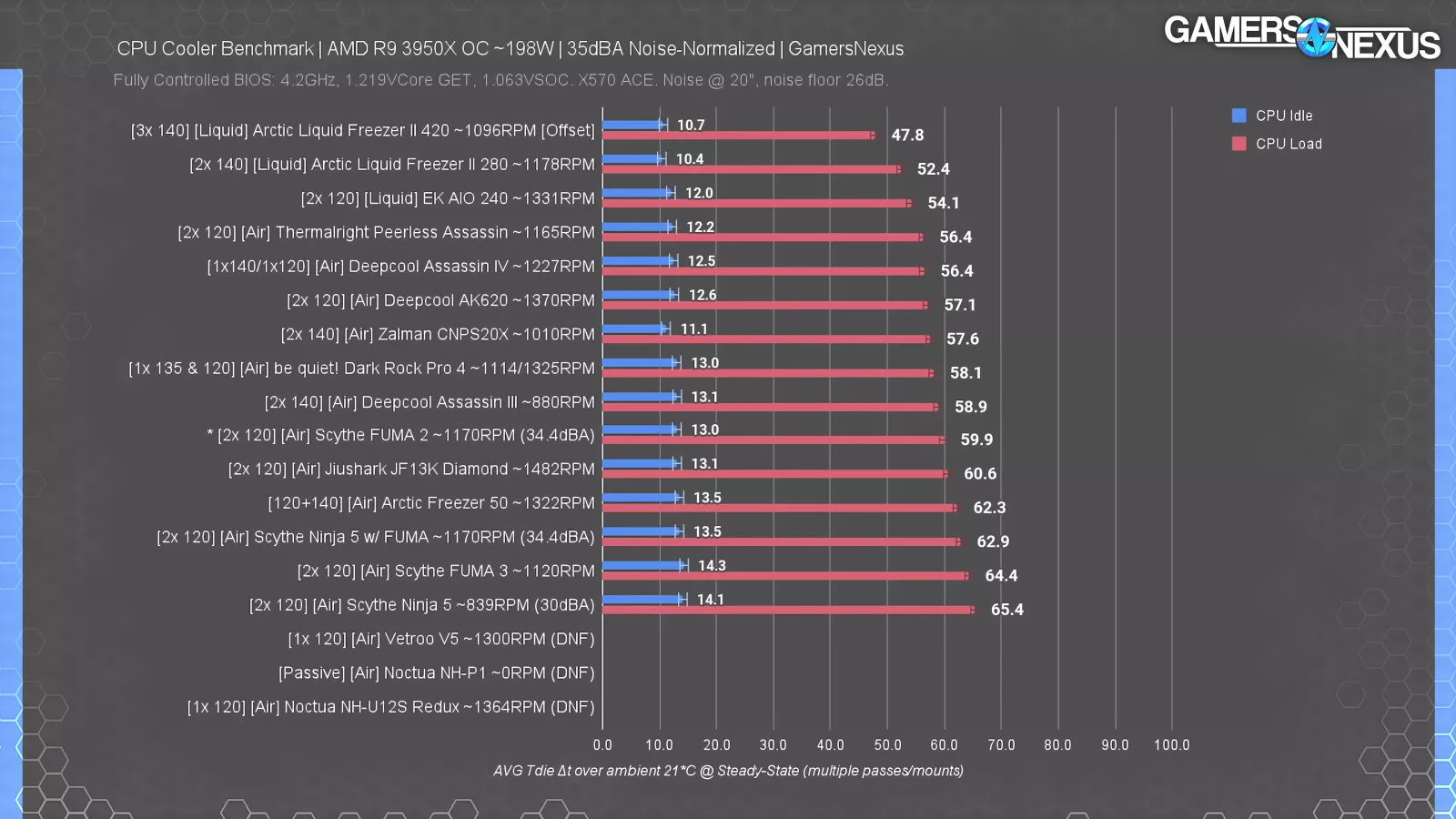
Here’s the 200W chart. The liquid coolers are there just for perspective.
The Peerless Assassin ran at 56 degrees here, with the Assassin IV within error. They’re the same. The AK620 is also about the same. The Ninja sets the floor - but we didn’t particularly like that cooler. The FUMA 3 is actually one of the reasons we’re retiring this bench: We expect it’ll perform better on a modern IHS, as some of the tuning that Scythe did was to the cold plate. That tuning may have affected the AM4 performance, or at least, the changes to the finstack are further hampered by the changes to the cold plate not meshing well with this test bench. With a couple days of retesting, we ended up at the same results. The FUMA 3 will have to go through our new test platforms to see if it does better there -- we suspect it will. It was a good push to move platforms though.
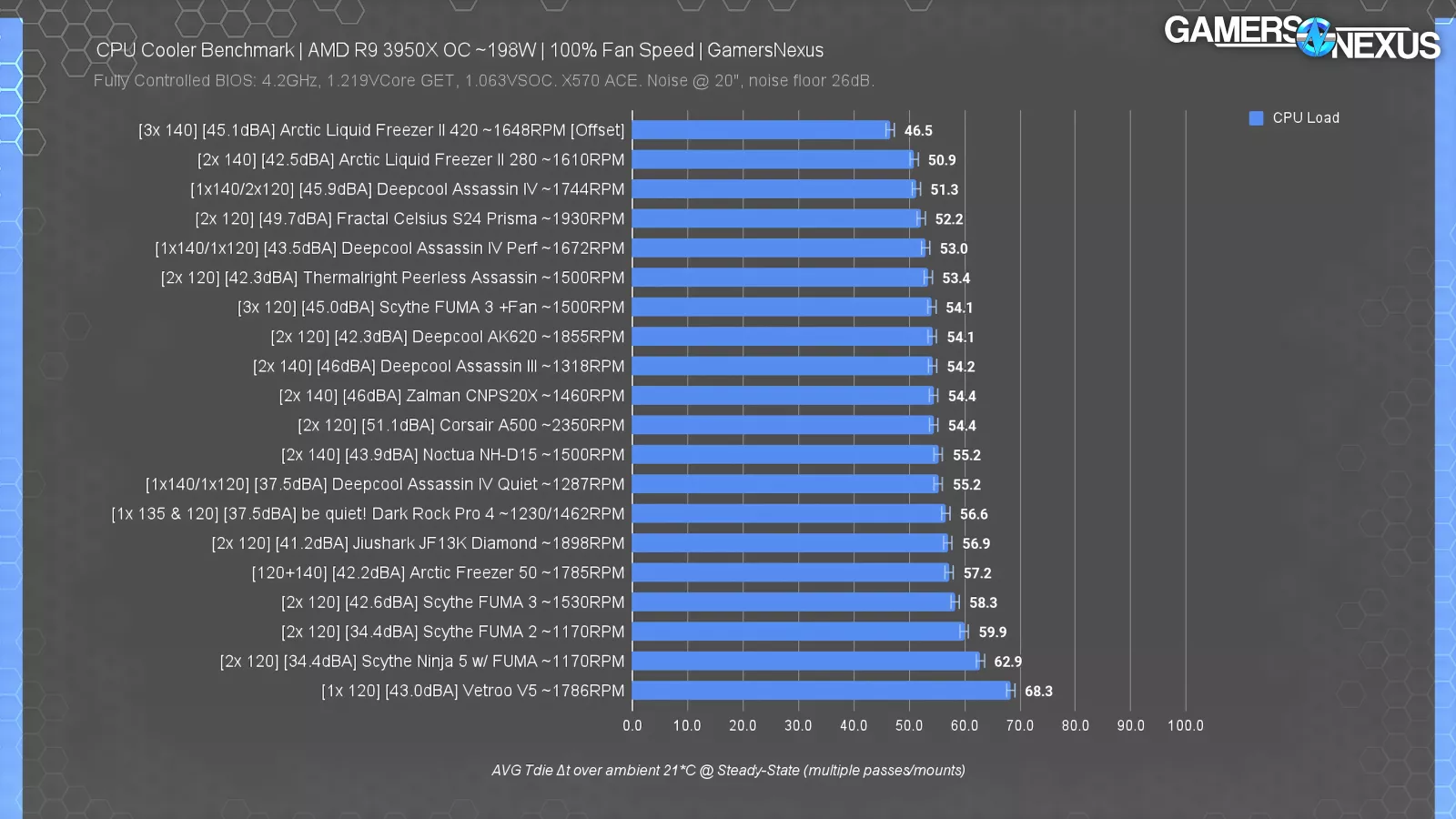
And here’s the 200W load at 100% fan speed, so there’s no like-for-like in the noise department. In this one, the Assassin IV with 3 fans blasted to the top, but also ran relatively loud. It’s about tied with the Fractal Celsius S24. The 2-fan solution is just behind it. The Peerless Assassin is also up at the top. Corsair’s A500 remains as a great example of an inefficient solution: At 51.1dBA, it’s barely keeping up with 44dBA and 46dBA alternatives.
In this one, the FUMA 3 is doing better than the FUMA 2, but it’s also louder, so the improvement is at the cost of noise efficiency.
The Vetroo V5 also enters this chart, setting the floor as a single-tower, single-fan solution.
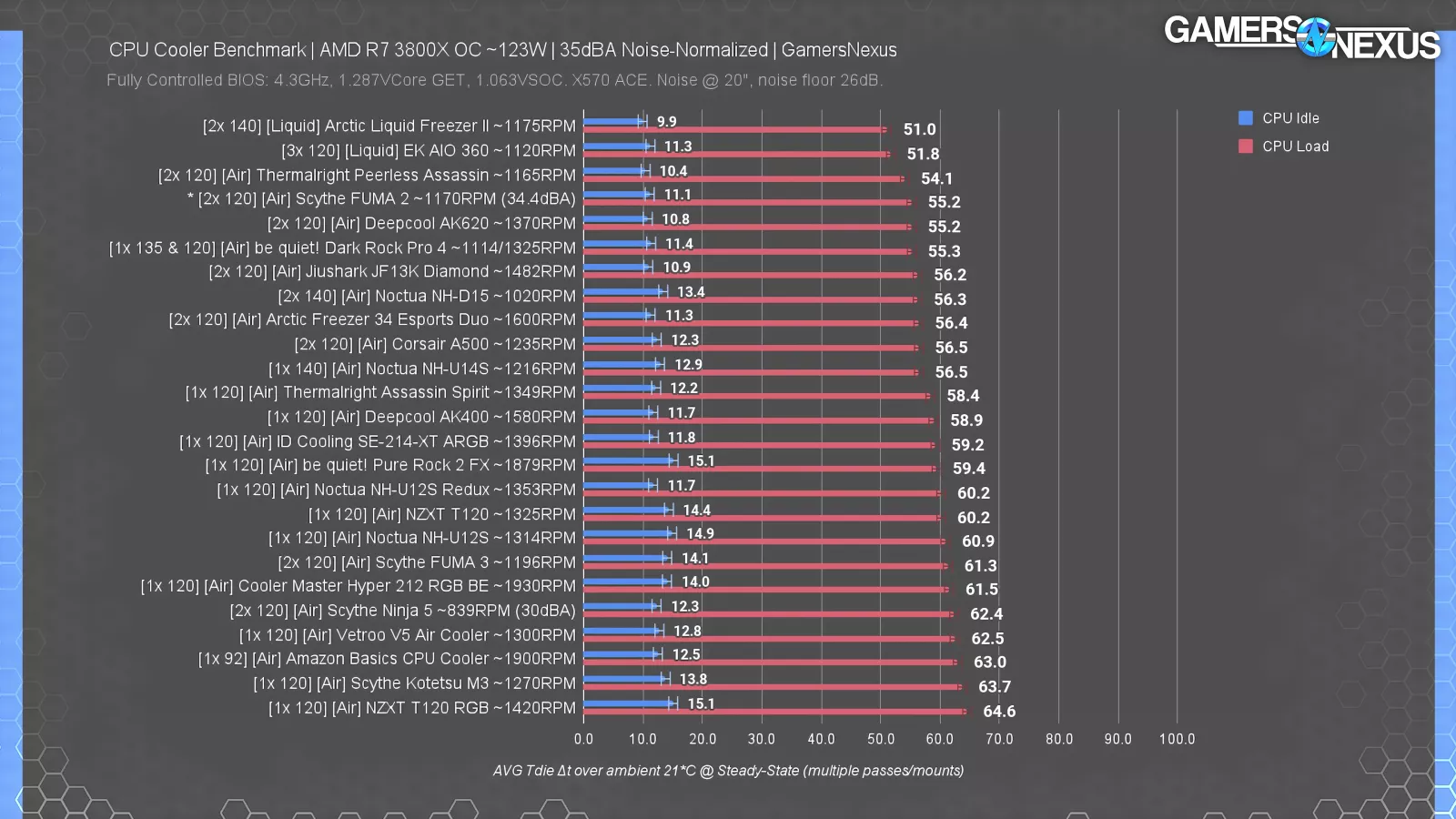
Here’s the 123W load chart at 35dBA. This one introduces a bunch of coolers we hadn’t previously published. Introduced here, we have the single-fan Kotetsu Mark 3, NZXT T120 RGB, the T120 non-RGB (which has a higher flow fan), the be quiet! Pure Rock 2 FX, the ID-Cooling SE-214 XT ARGB, Dark Rock Pro 4, and FUMA 3 were all added for this final round of charts before we move to our new platforms.
Of these, the leaders remain the Peerless Assassin and FUMA 2 when noise-normalized. The Assassin IV wasn’t run here as it’s overkill for the load. The AK620 and Dark Rock Pro 4 rank alongside the FUMA 2. For single-fan coolers, the Noctua NH-U14S leads, followed by the Thermalright Assassin Spirit at 58 degrees -- kind of a wide gap between the two. The AK400, ID-Cooling SE-214, and Pure Rock 2 FX are all similar. NZXT’s T120 doesn’t do great, down at 60 degrees over ambient, but it’s OK. The RGB variant consistently ran about 4-5 degrees worse in our testing here, which aligns with the reduced flow on the fan.
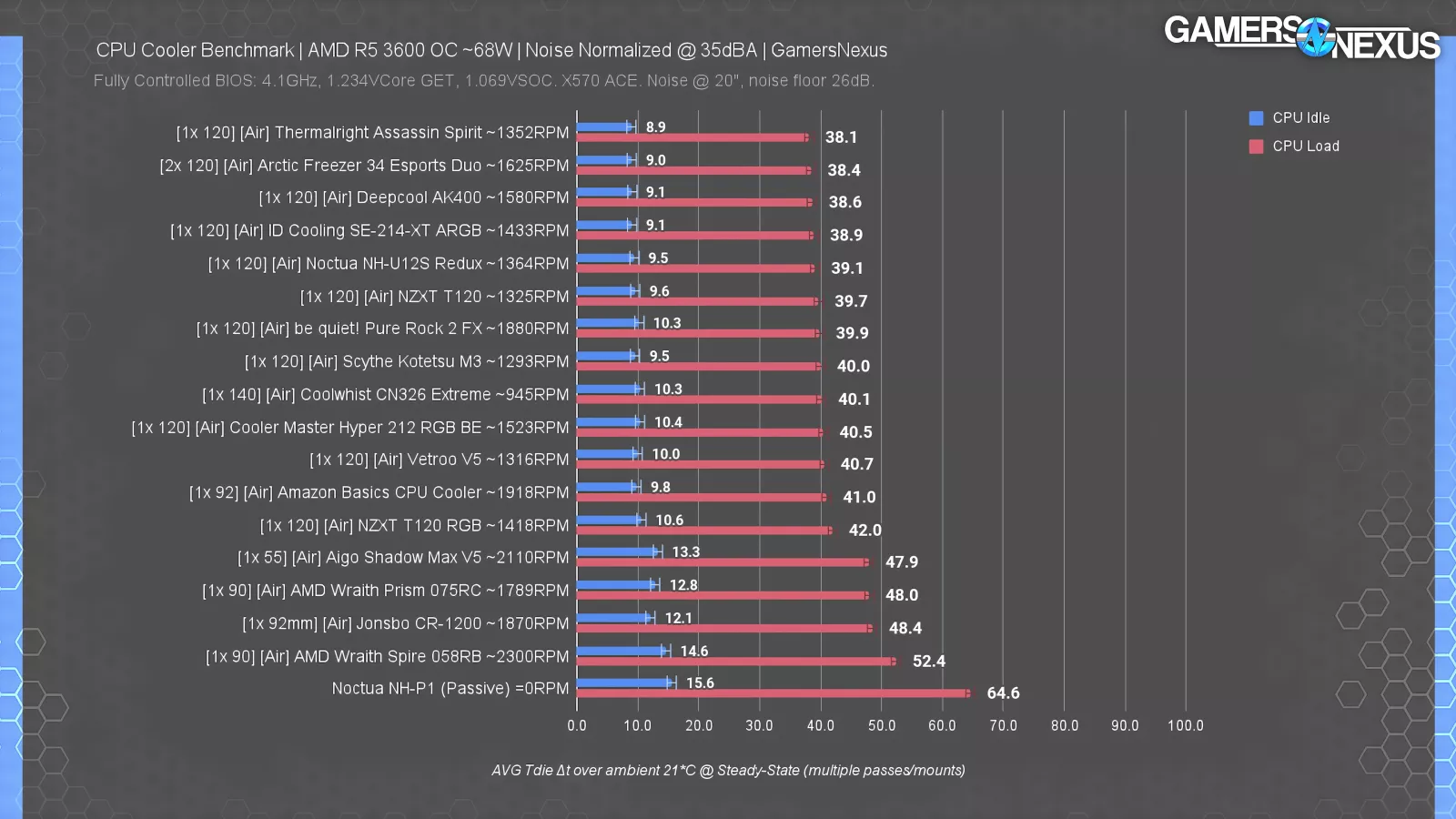
Finally, at 68W and noise-normalized, the Assassin Spirit, Esports Duo, AK400, and ID-Cooling SE-214-XT ARGB are all about the same. The 214 is impressive here for its value. The T120 and T120 RGB again punch below the average result for a single tower, but at least are doing better than the small coolers on the chart. Almost everything is doing better than the stock coolers. The NH-P1, which has no fan, is within spec and not throttling.
Best Ultra Budget CPU Air Cooler: Jonsbo CR-1200
Jonsbo CR-1200 | Original Review
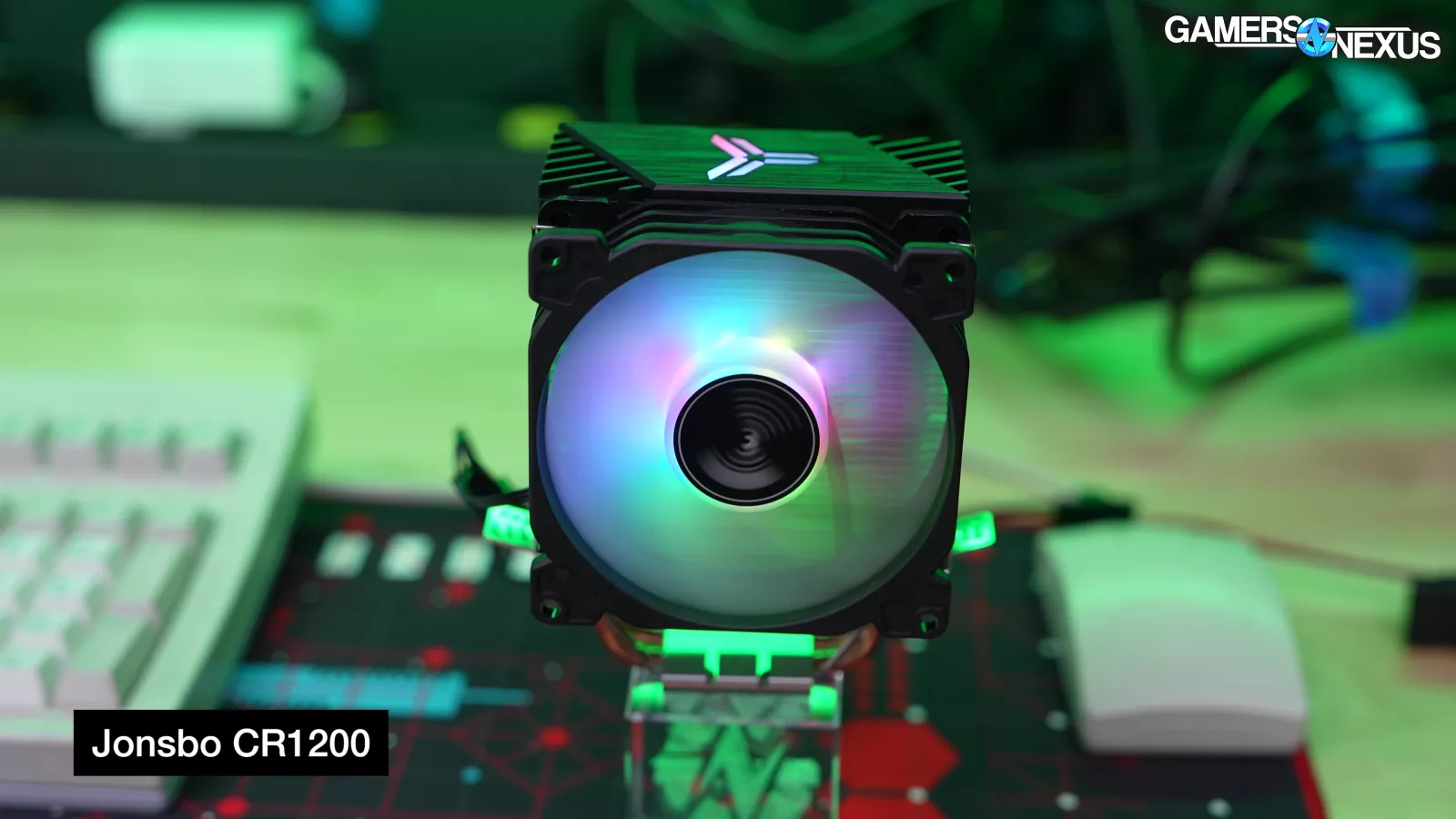
The next award is for the Best Ultra Budget cooler. The objective here is the cheapest possible cooler that technically gets the job done, even if it’s not great -- and this is obviously aside from included coolers.
We’re giving this to the Jonsbo CR-1200. We reviewed it previously. We bought it on sale for... $2.27. This model is only compatible with AM4, not AM5, and also doesn’t list LGA1700 support -- it’s not that useful unless you’re working with older systems and don’t want a stock cooler.
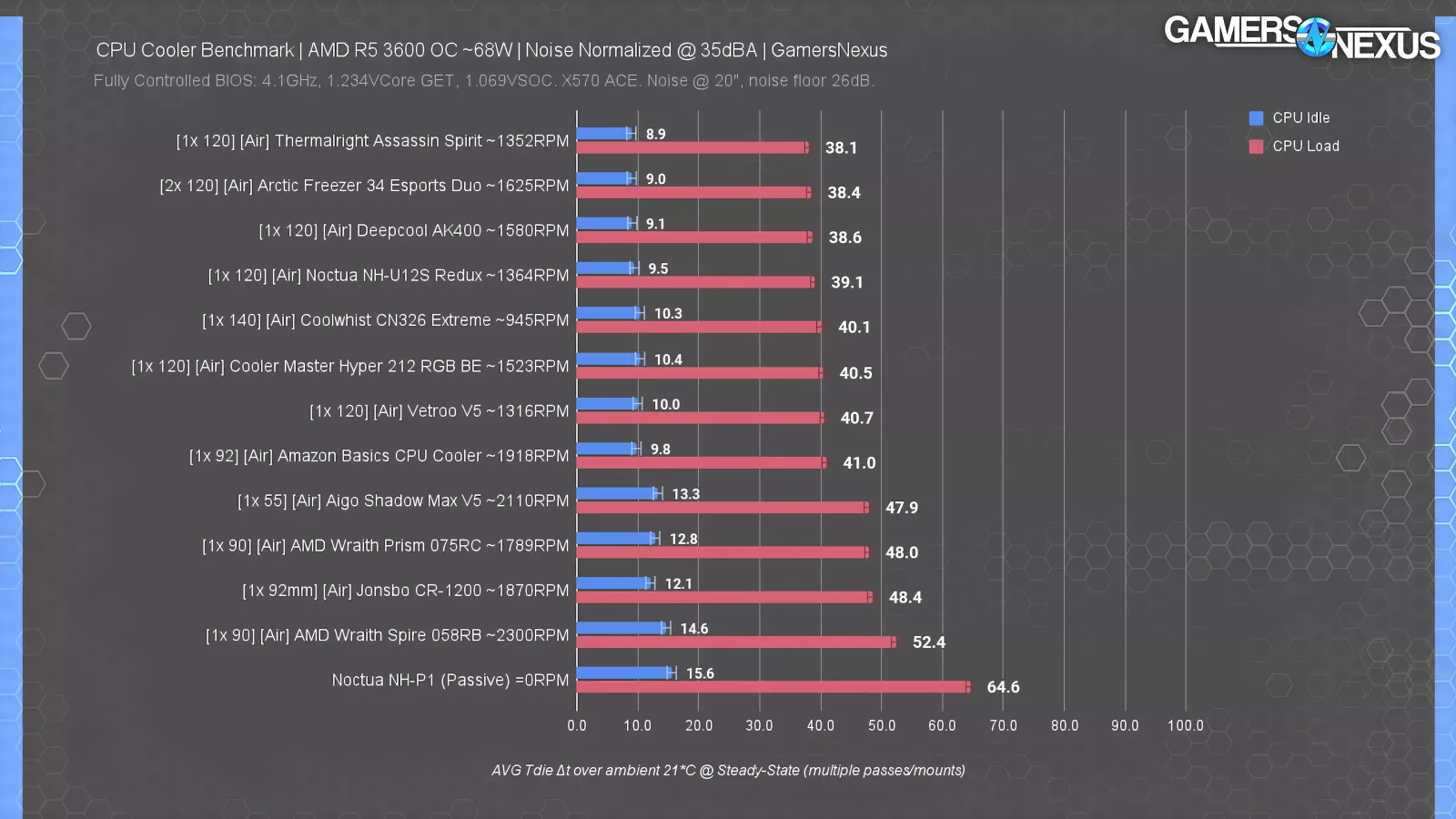
But to its credit, when we reviewed it, it was able to sustain the 68W load at 35dBA normalized, keeping it below the Wraith Spire and about tied with the Wraith Prism. At 100% speed, it ran at about 39dBA and was quieter than the Wraith Prism, or about the same as the Spire, with the results landing accordingly.
This cooler is cheap, it feels cheap, its fins are flexible, it makes metallic noises when you breathe on it the wrong way from the flimsiness of the fins, and generally speaking, it’s not particularly good. The fan is only 92mm, but somehow, it manages to still have LEDs. The mounting uses AMD’s clip-based mount.
But in spite of all of these things, the cooler passes on the technicality of getting the job done -- and because it’s $2-$3, it’s kind of amazing. Depending on use, this is basically a small upgrade over a stock cooler -- but maybe not worth it. It might make more sense in situations where you have no cooler at all and where you can wait a few weeks to get it. But we still wanted to mention this dinky cooler for its oddly good thermal performance. It seems physically impossible that this is profiting, so maybe there’s some kind of subsidy going on -- but either way, $2.27 (or whatever it is at the moment) is comically low.
Best Mechanical Design CPU Air Cooler: DeepCool Assassin IV
DeepCool Assassin IV | Original Review | Amazon | Newegg
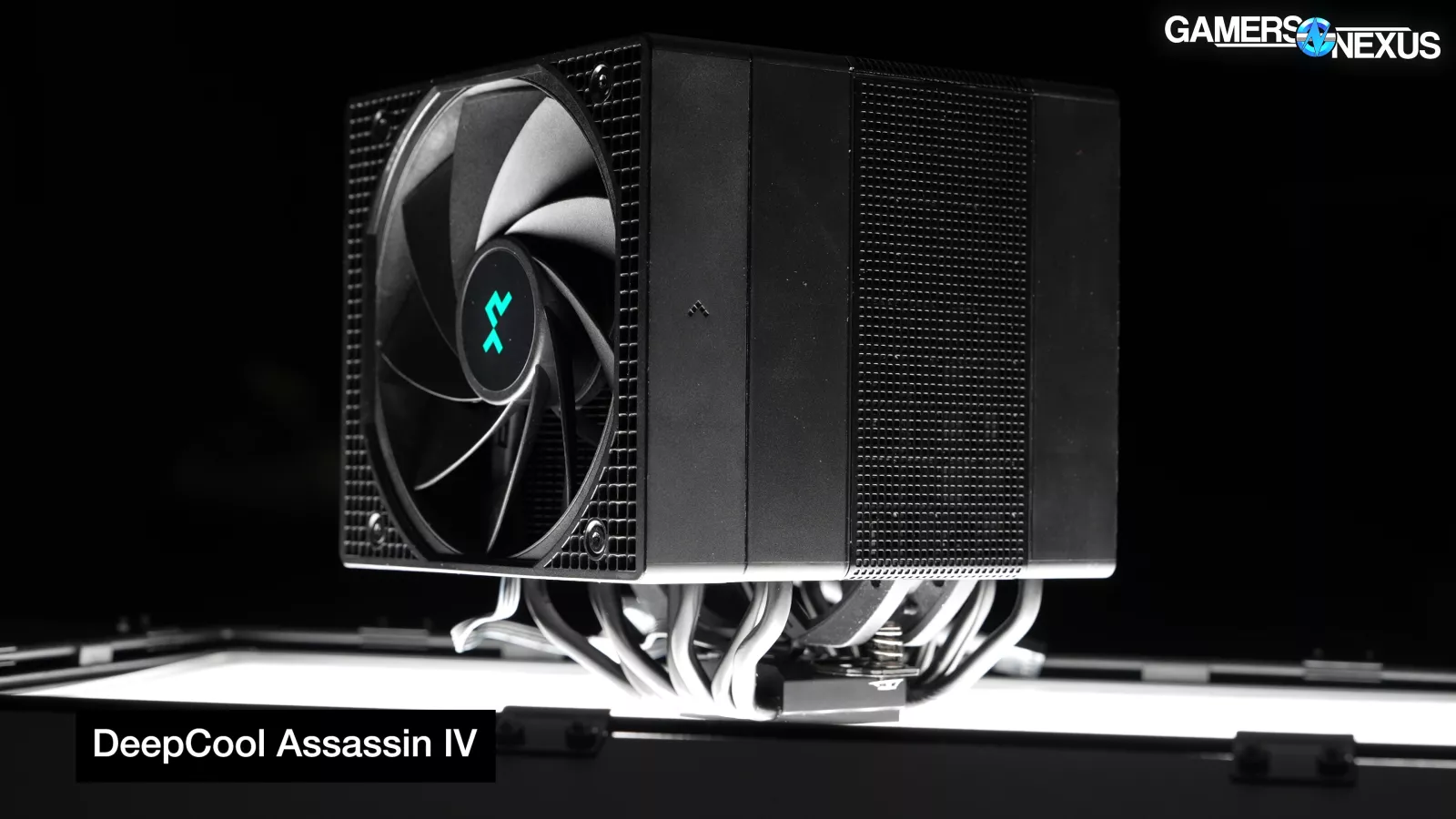
The next award is for Best Mechanical Design. This section covers the overall considerations and quality of life features, the pressure distribution, the installation, cable routing and cleanup, aesthetics, and usability.
For this, we’re giving it to the DeepCool Assassin IV. The Assassin IV isn’t a good value cooler, and we talked about that in our recent review. At about $100, +/-$10, it’s an expensive, dual-tower, dual-fan solution, but DeepCool put a lot of effort into making a flagship that looks good, cools competitively, and considers usability.
DeepCool’s Assassin IV is a brick of a cooler. It’s a dual-fan cooler, with one 120mm fan on the back as a pull fan and one 140mm fan that sockets centrally. It’s hard for cooler manufacturers to differentiate themselves at the high-end once they’ve reached performance limits.
Small attention to detail elements set them apart: We liked that DeepCool includes a hidden cable channel that’s notched into both the plastic fan housing and the finstack, allowing clean, pinch-free cable pass-through.
The back of the cooler also uses a slightly concave design that allows more of a gap to form between the rear fan hub and the fins, which helps reduce the hub deadzone that can form.
The central socketing fan has a downside, which is that not just any 140mm fan will fit. That reduces compatibility severely to just exact replacements or one older DeepCool model. The upside of this is that it allowed DeepCool to reduce the overall height of the cooler, thus enabling them to fit a 140mm fan without hurting case compatibility. The fan sinks deeper into the channel as a result. On the positive side, mechanically, the socketing and unsocketing of the fan is well-designed and of good function.
DeepCool additionally includes a fan mounting kit to add a third fan, something we tested in our review and with which we found a small improvement in performance. These can fit most 120mm fans.
It’s also extremely easy to adjust the fan height for motherboard I/O area clearance, like heatsinks, or for RAM clearance if you add the third fan. We had some critiques of the mounting solution, but overall, its pressure maintained good contact centrally on the AM4 CPUs we tested.
Other small touches are primarily aesthetic, but at this cost, they need some of that too: The cooler has a checkerboard pattern on the front that has become a bit of a DeepCool theme. Functionally, any benefit would be irrelevant and probably nearly impossible to measure outside of simulation. But it looks cool.
The cooler also uses easily removable mesh cover plates to hide the central fan. These aren’t designed as part of the heatsink itself, but provide a mechanically simple cover.
We also like that the cooler includes a physical hardware switch for a “quiet” mode and “performance mode.” This is done by using a resistor to reduce the power delivery to the fans, thus slowing them down. You could do this in BIOS, but adjusting the curve with hardware can be easier for some builds.
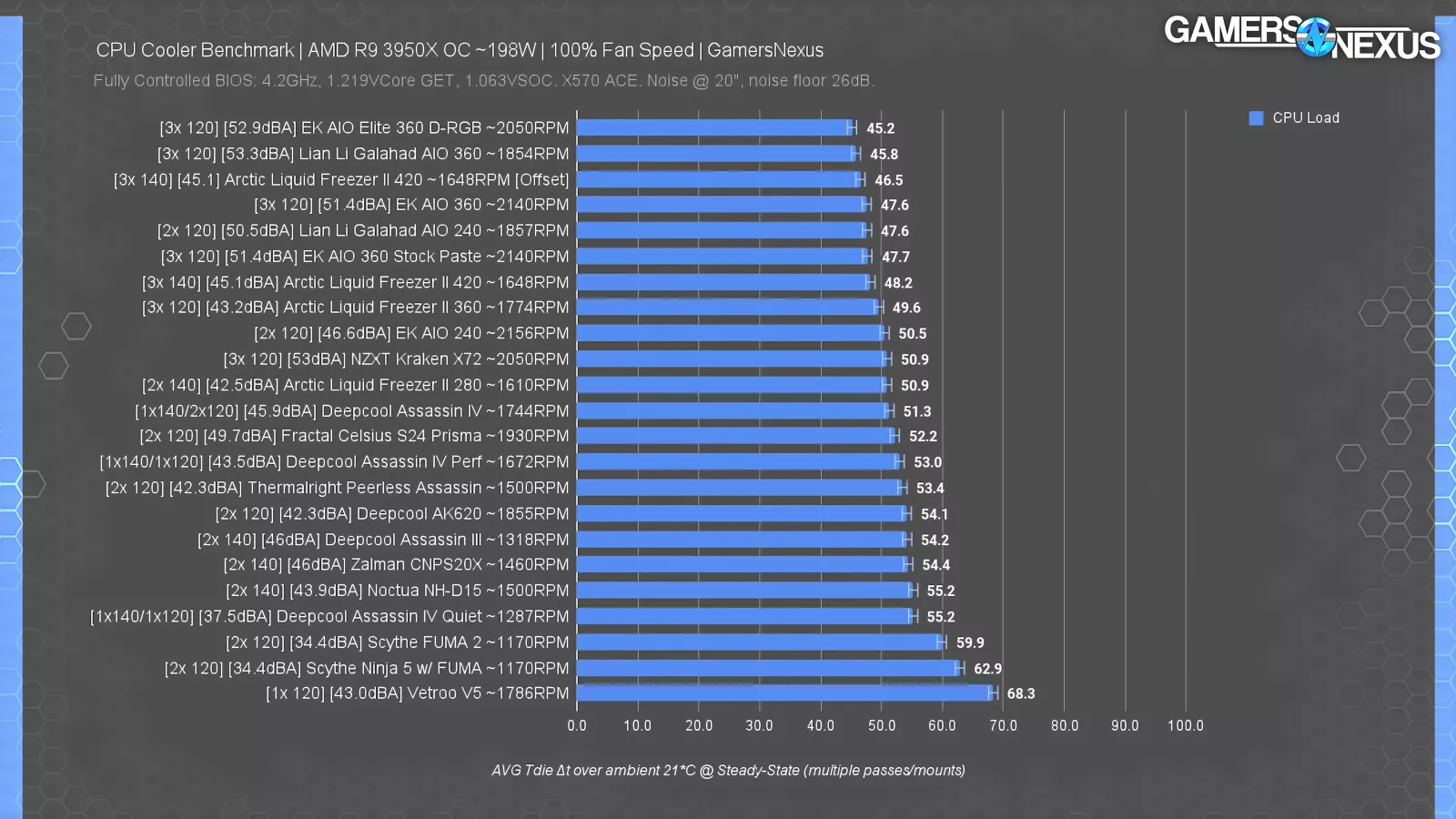
In our testing, we found the Quiet variant to run at 37.5dBA when at 100% speed, resulting in a 55-degree result at 200W. The performance result ran at 43.5dBA at 100% speed and 20” distance, resulting in a 53-degree result.
Our biggest complaint was of a fan whine that we heard. We have samples of that in our video review if you’d like to listen. It’ll go unnoticed in builds with sufficient neighboring noise, but would be noticeable in silence-focused builds. Overall though, the Assassin IV had the highest build quality of any air cooler we tested this year.
Conclusion
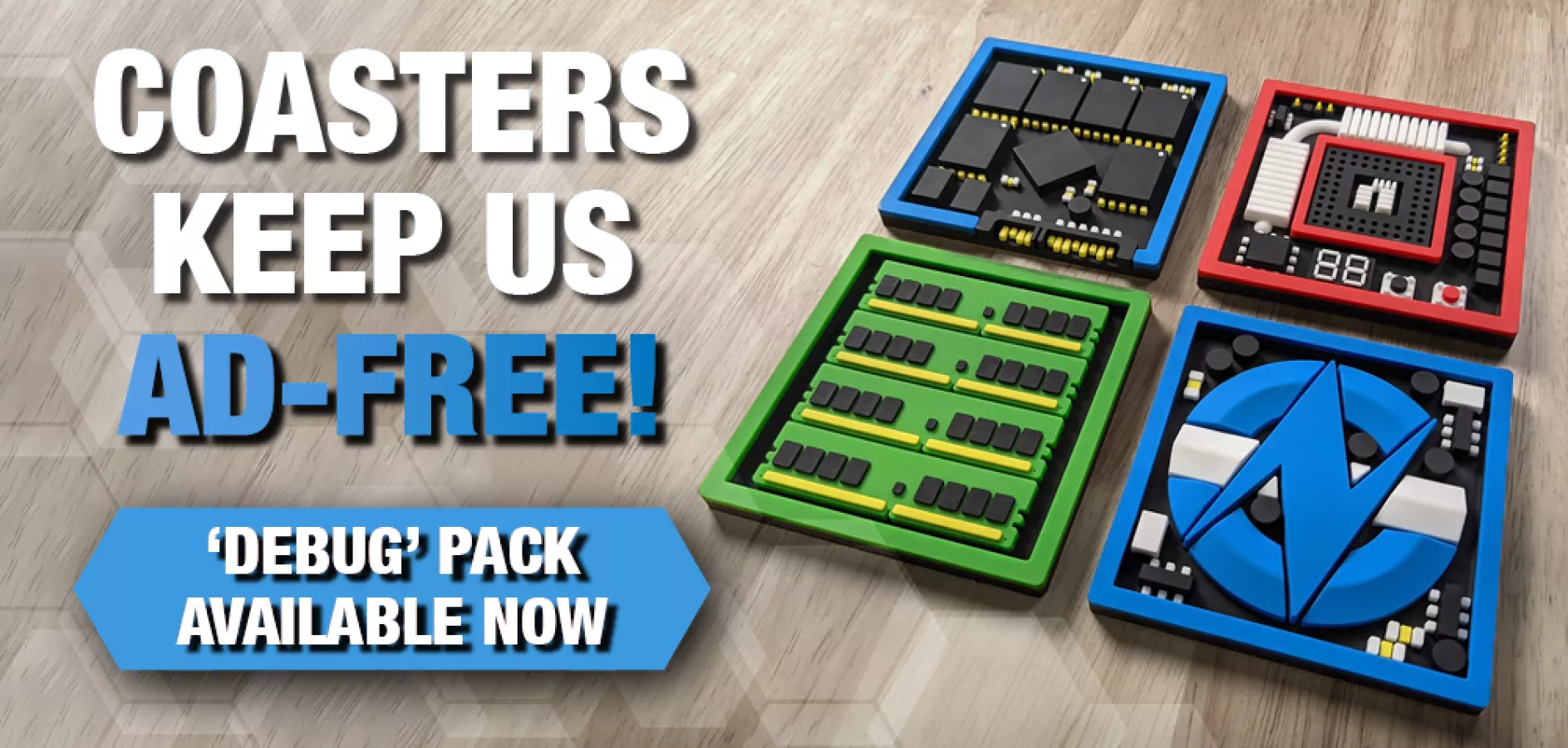
We’ll be back with two brand new test platforms for our CPU cooler methodology, and we’re thrilled to introduce them because it’ll be alongside full deployment of our acoustic chamber. We’ve shown it in use in some one-off pieces, but coolers will be the first to get it as standard treatment. We’ve already run nearly a dozen coolers through it. You can also check out our Mega Charts for coolers over here, featuring every cooler we've tested.
The new platforms will be both AM5 and LGA1700, which gives us a look at two distinctly different heat spreader designs. We couldn’t do this before because we didn’t have the manpower or processes in place to double the work, especially because one cooler already takes about 40 hours to review. But now we can, and we’re hyped to get into it with the new setup.
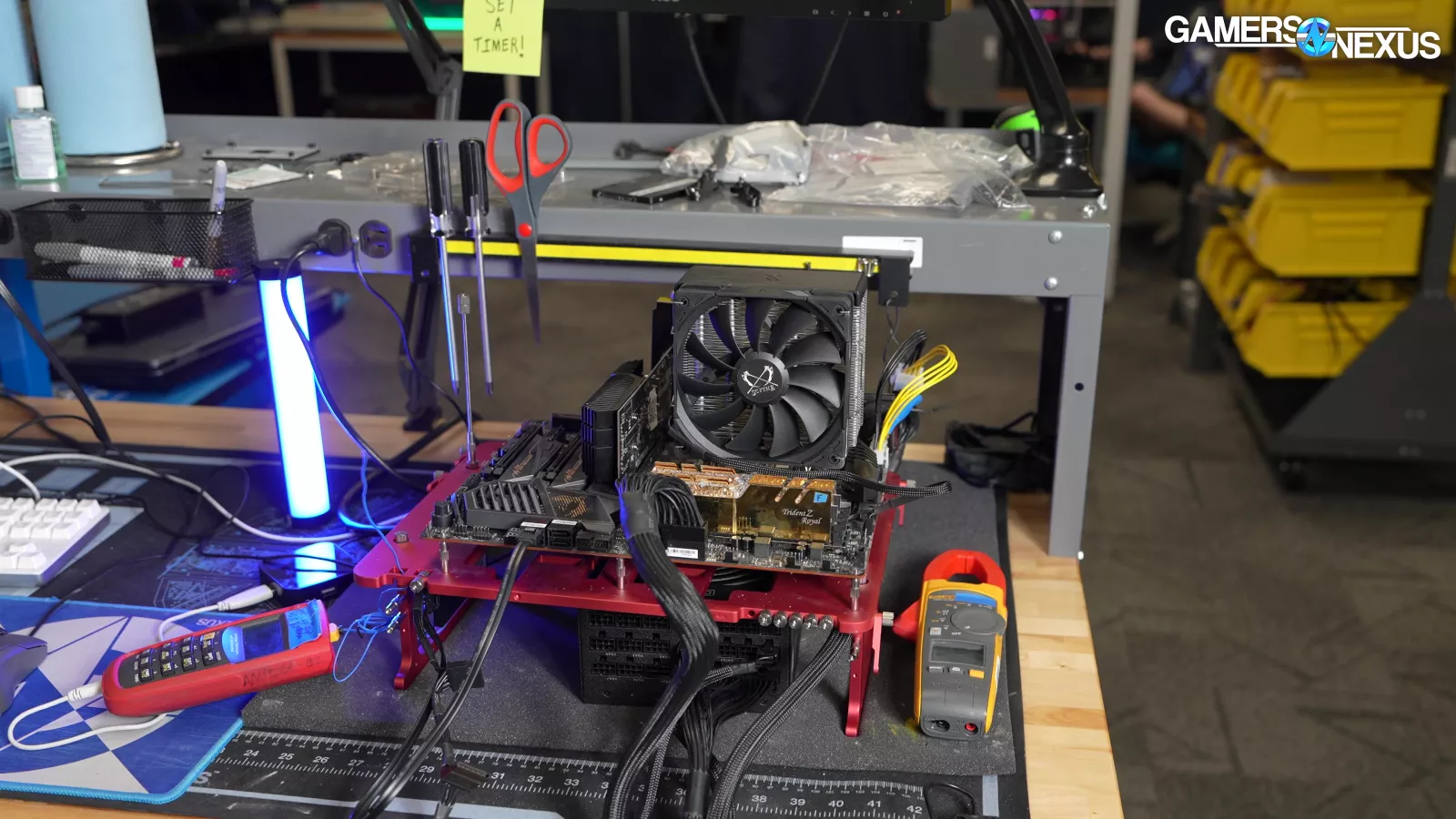
In the meantime, this gives you a look at a mature test methodology that has had 3 years to bake. Even outside of AM4, for the most part, this gives you a good representation of performance as a baseline. And besides, AM4 is still getting heavily bought right now.

